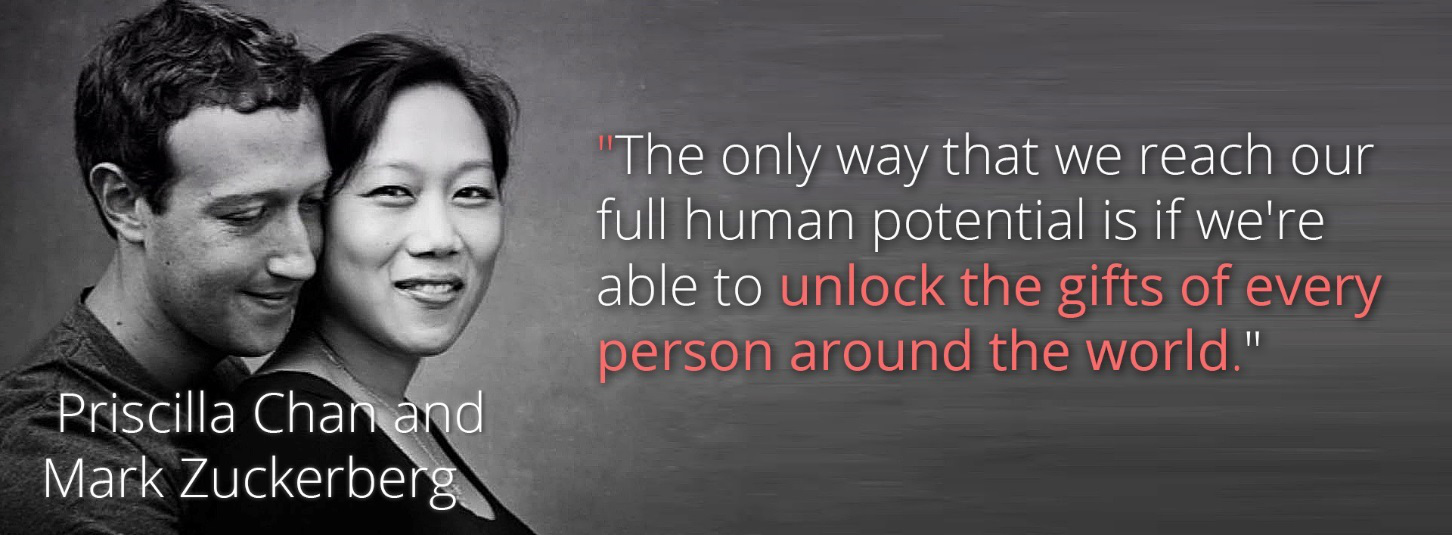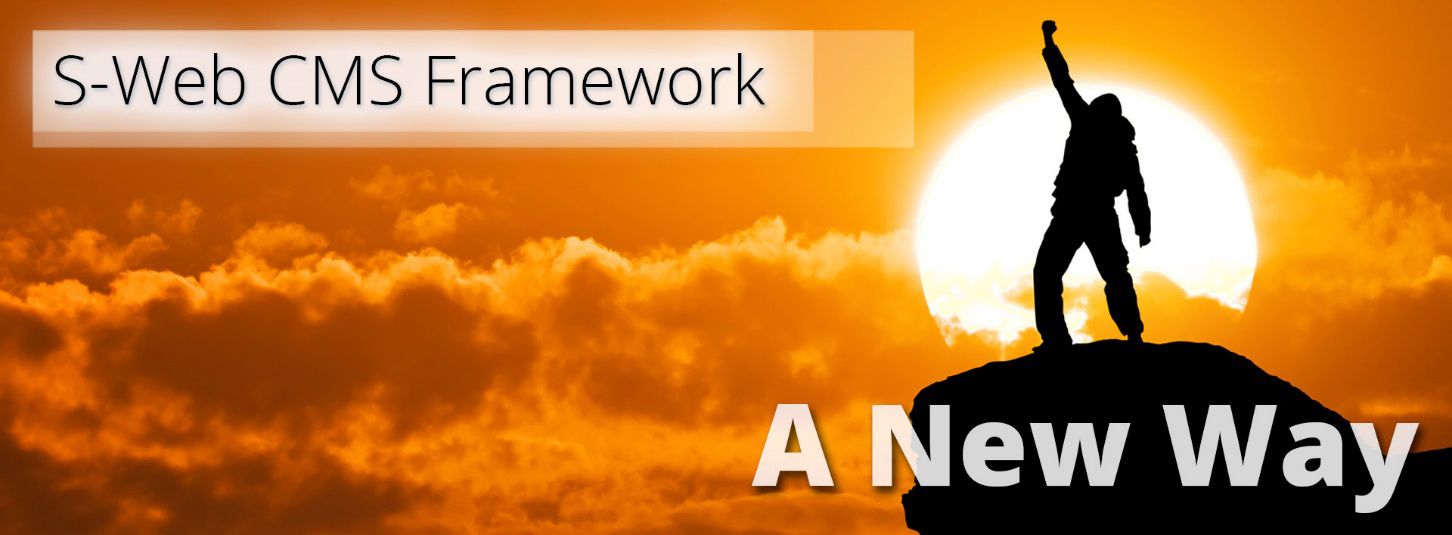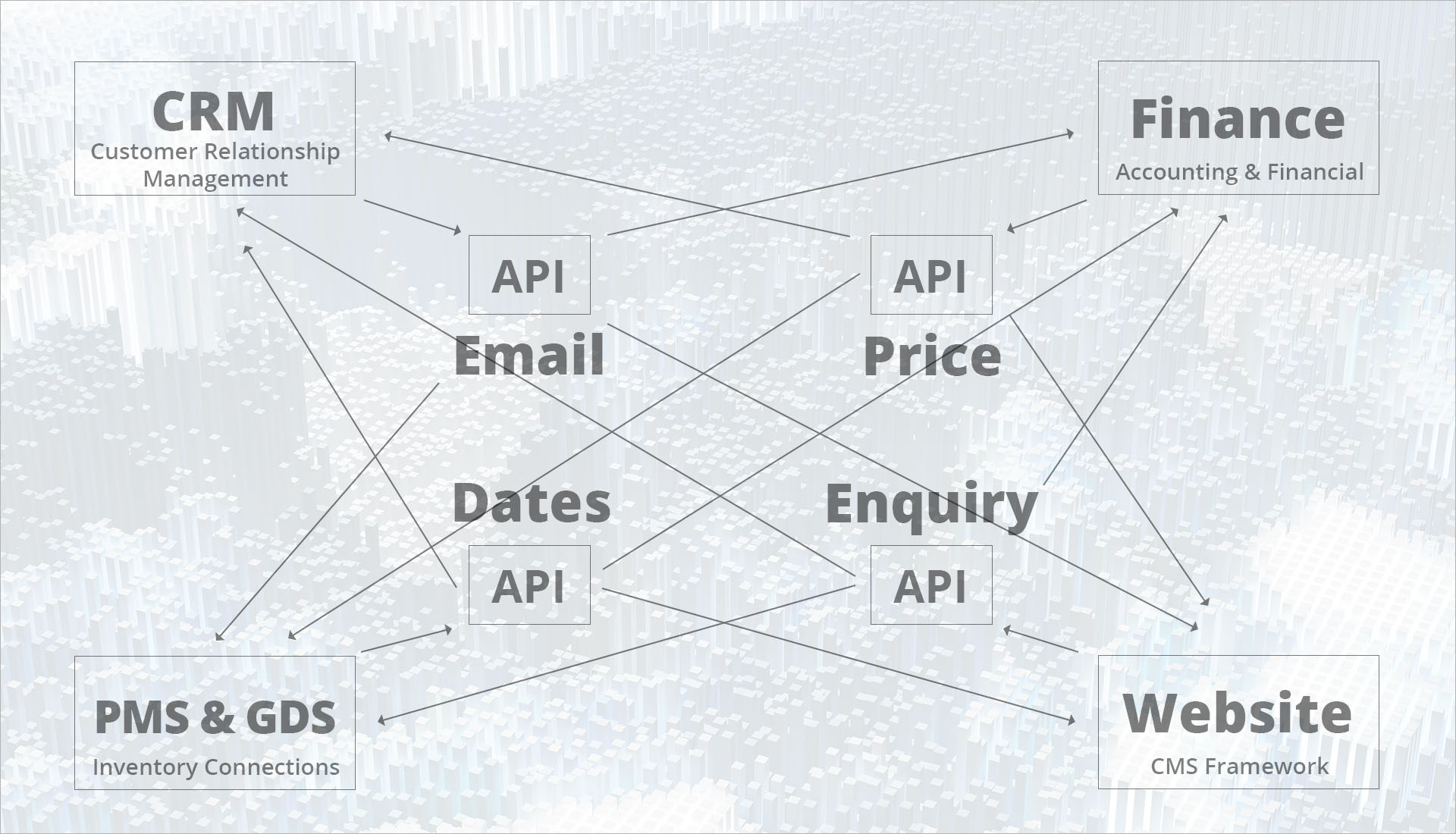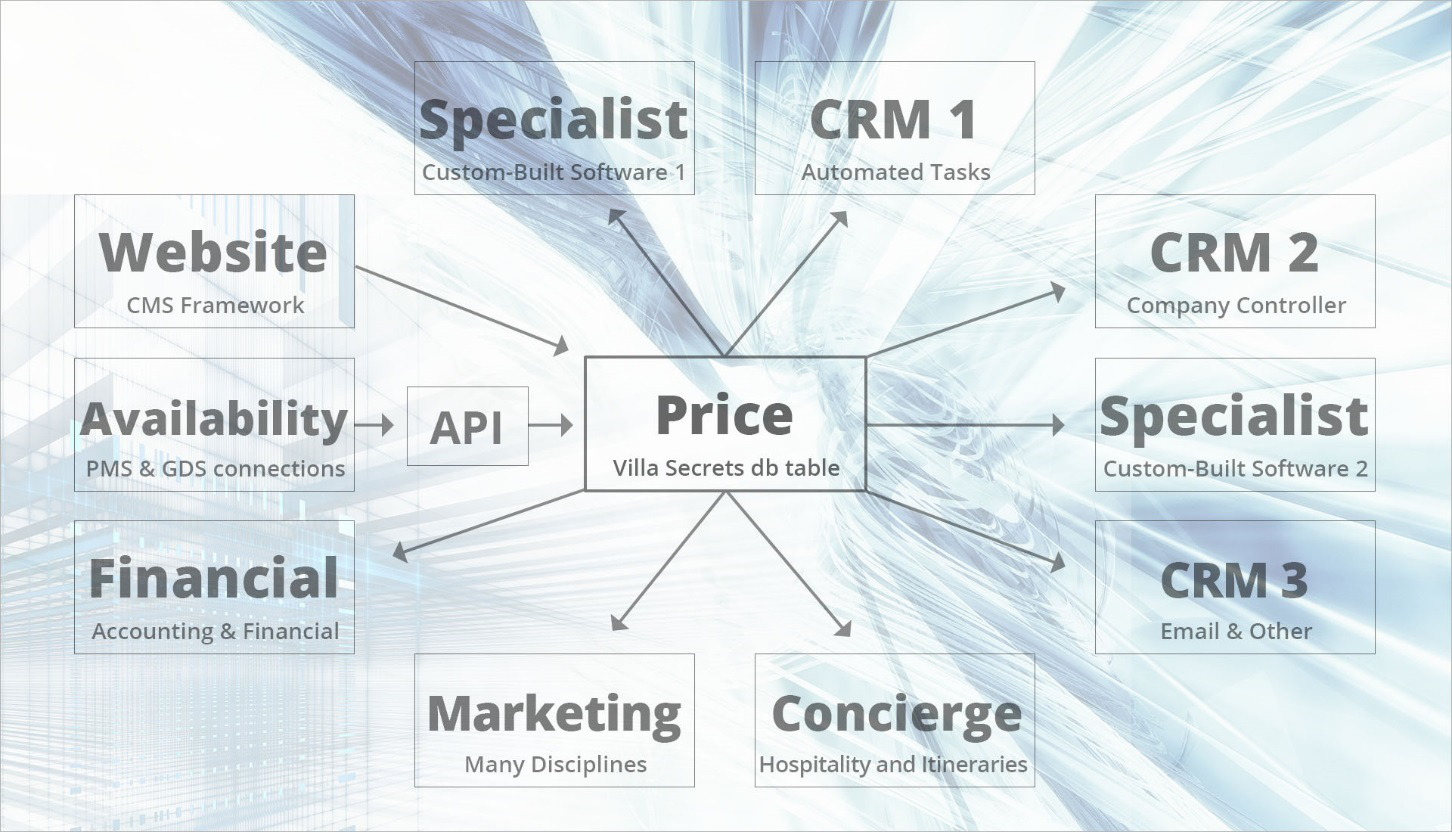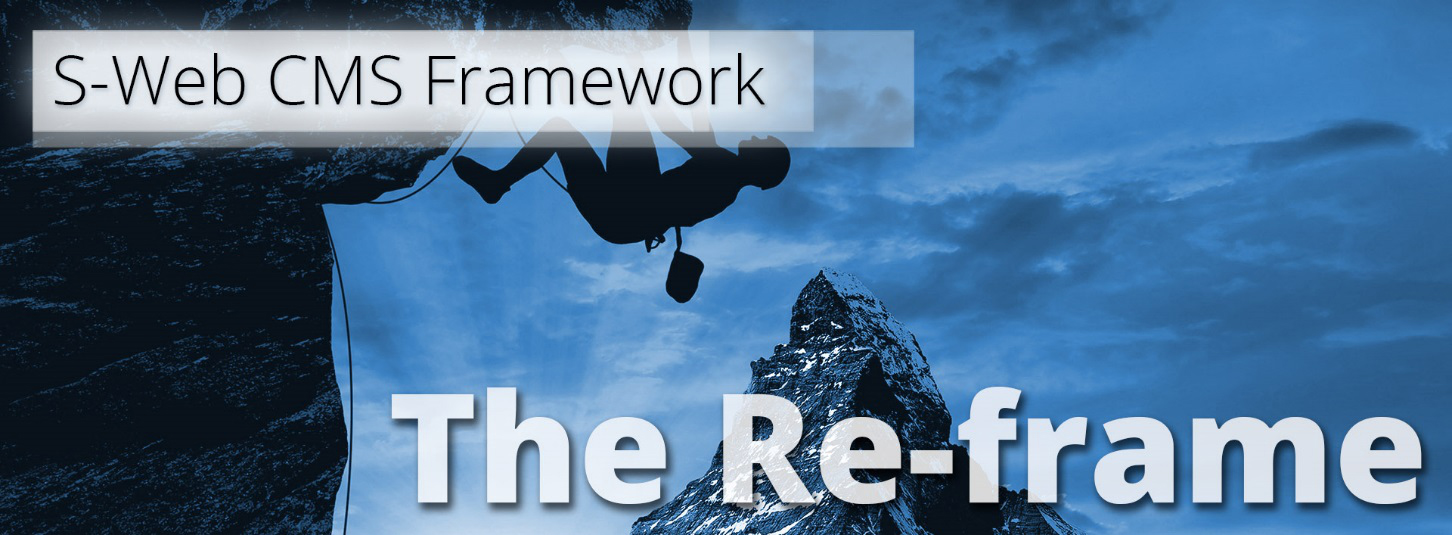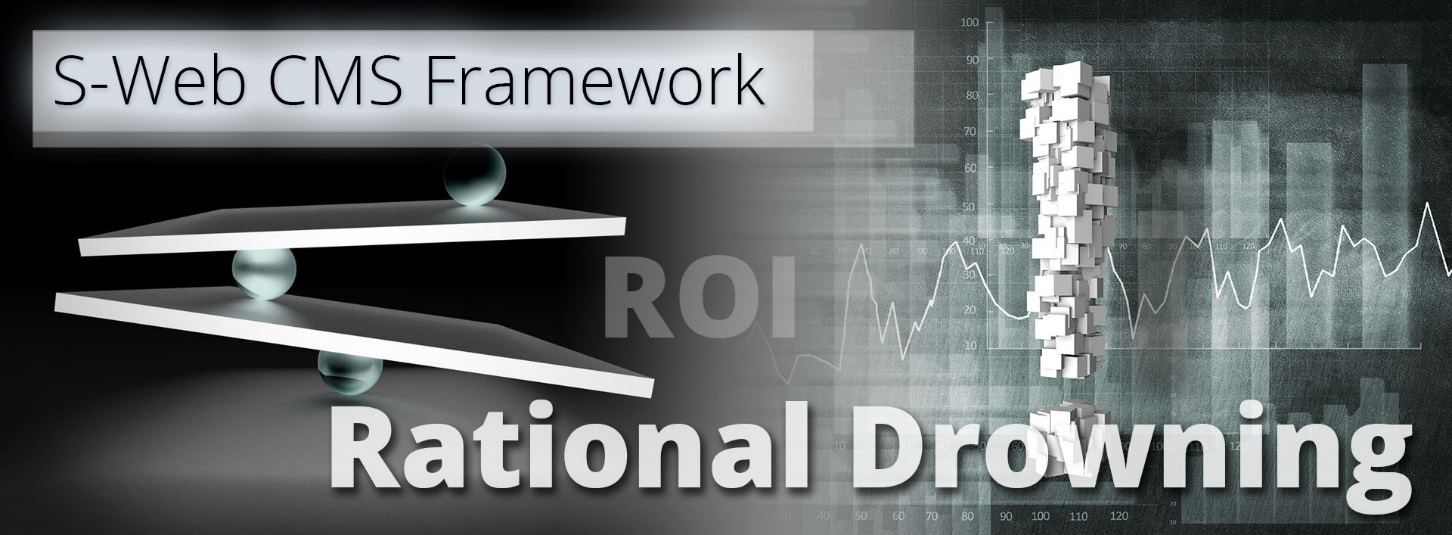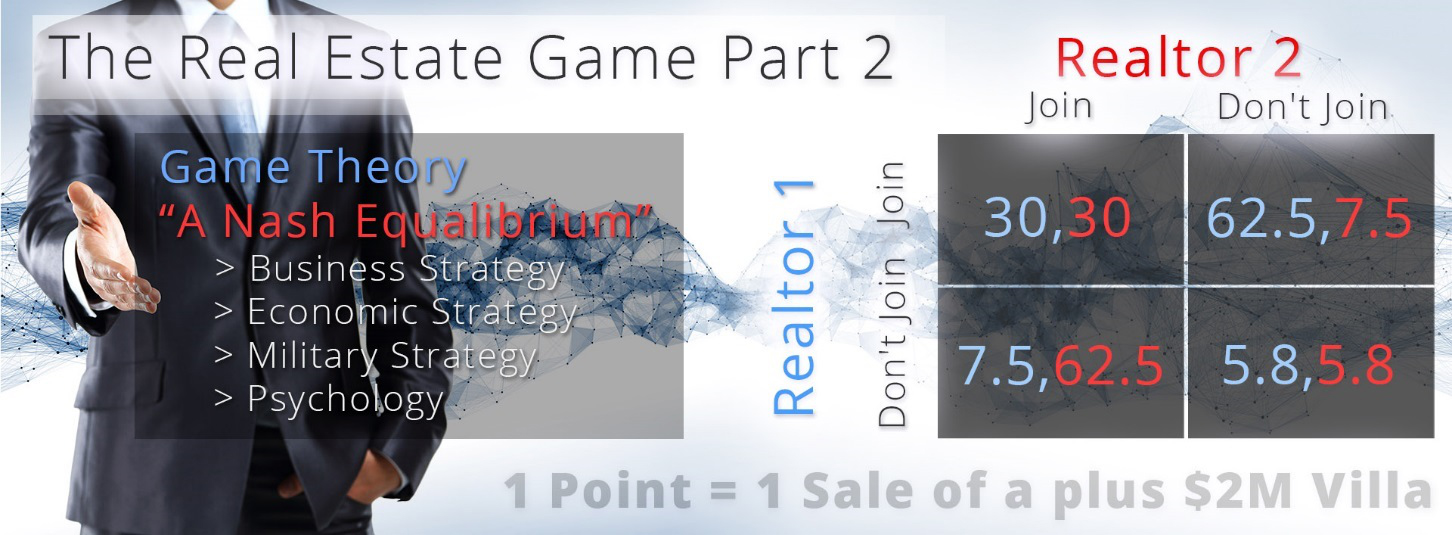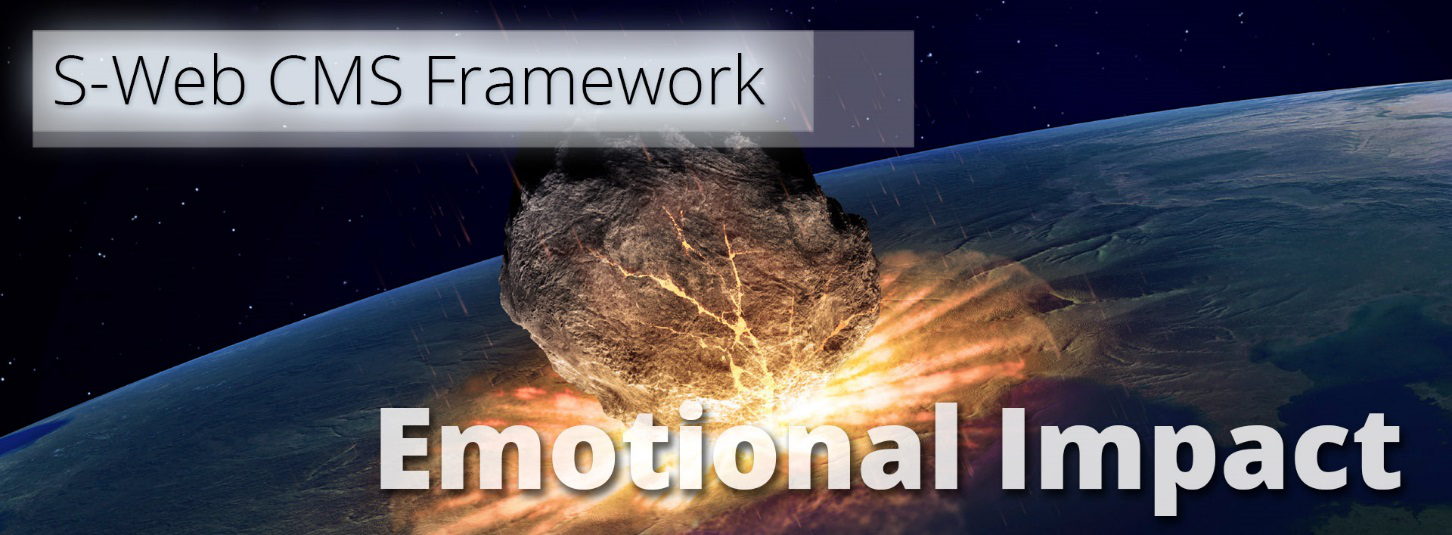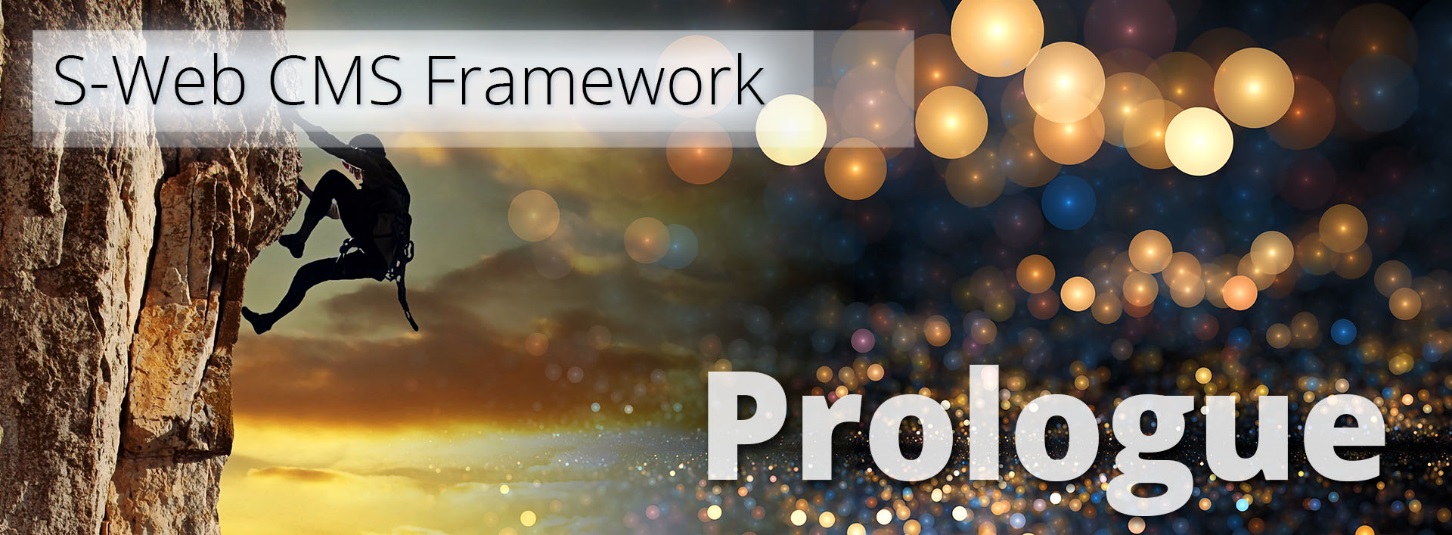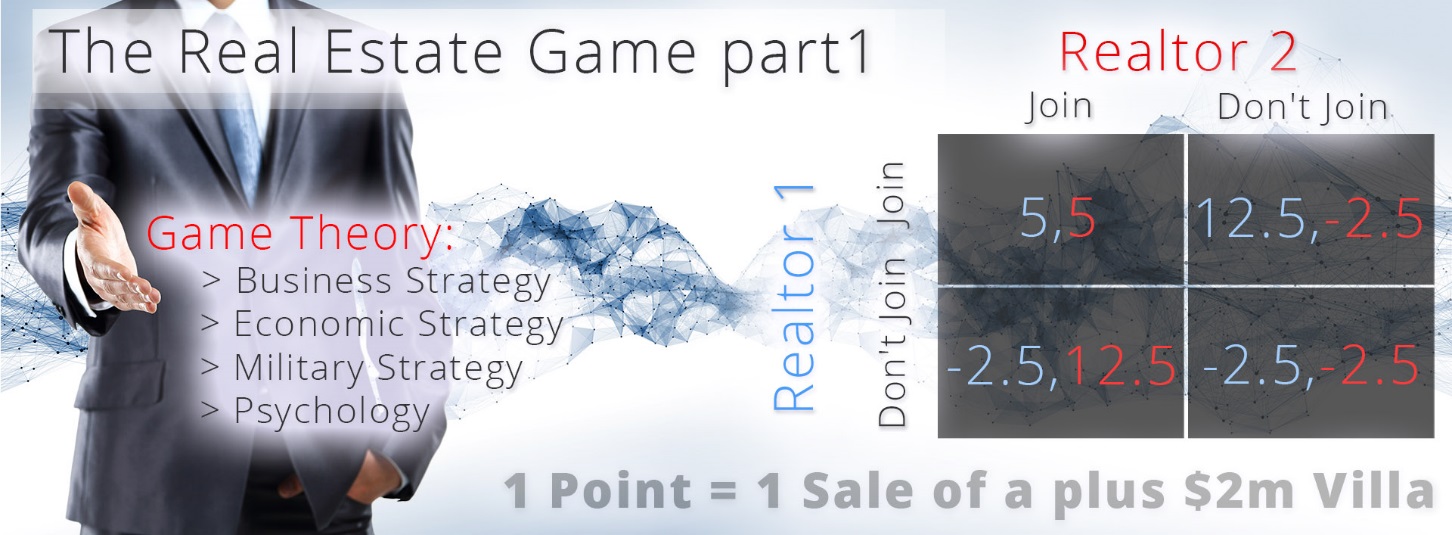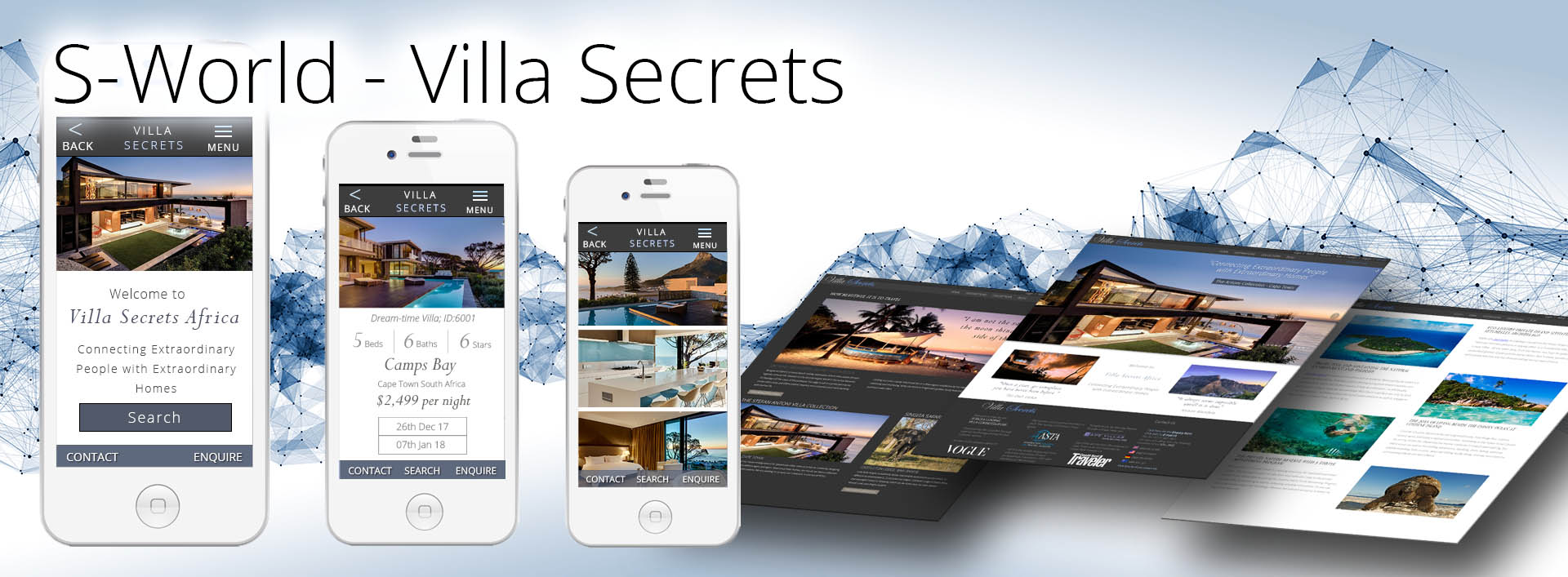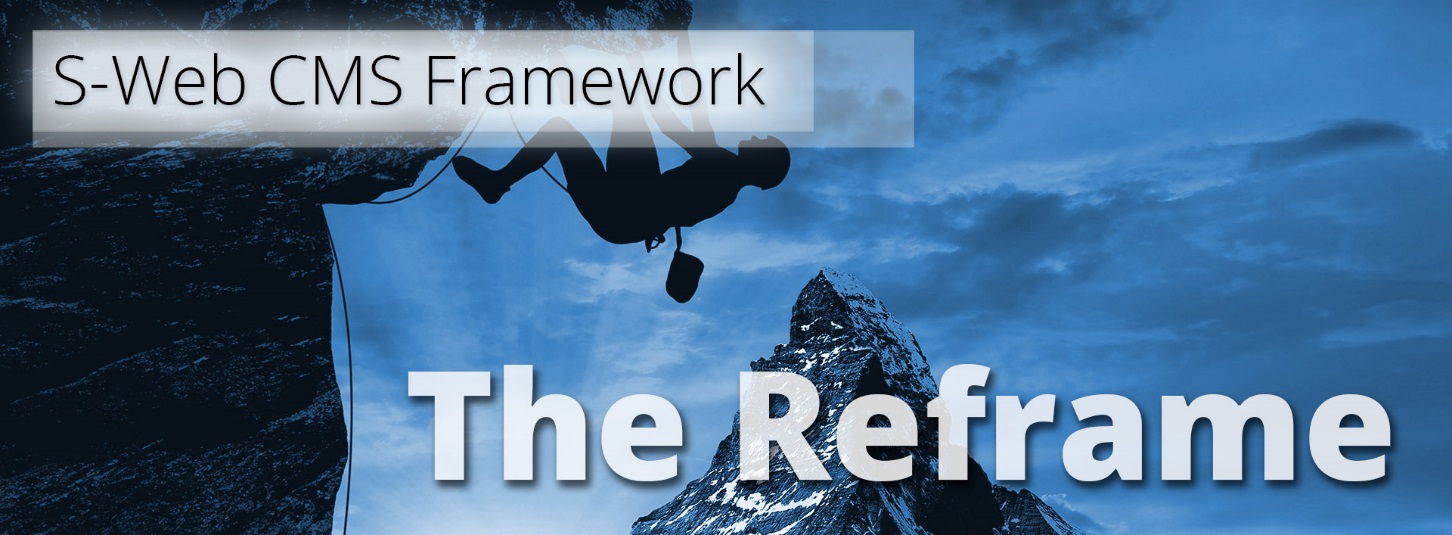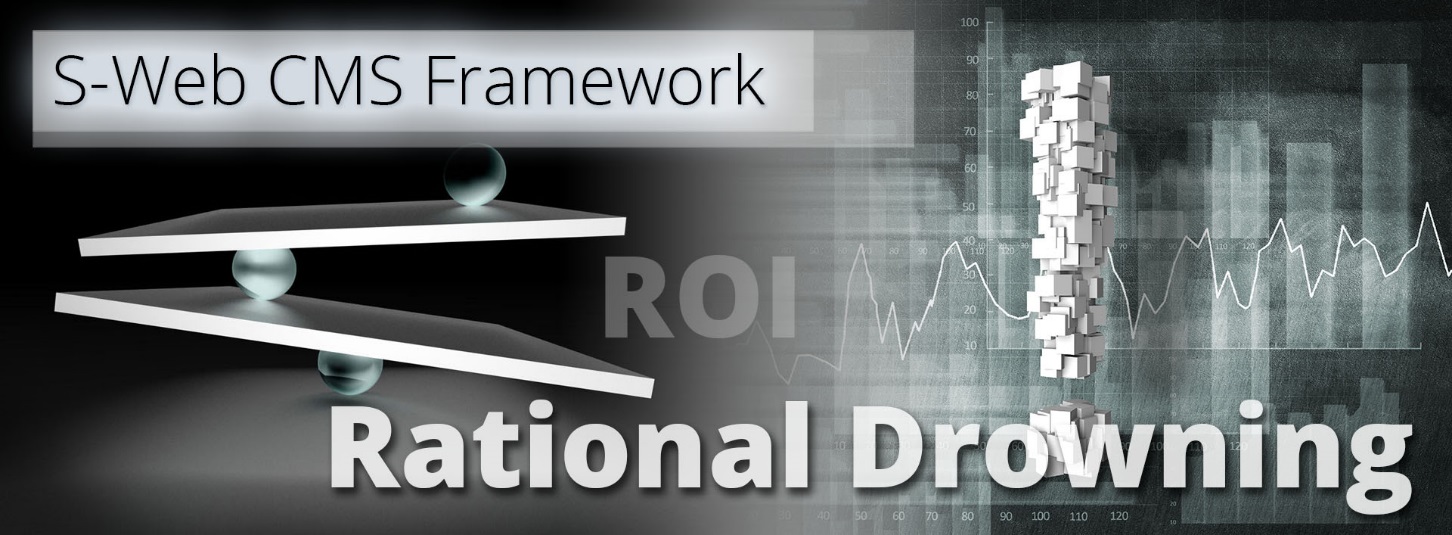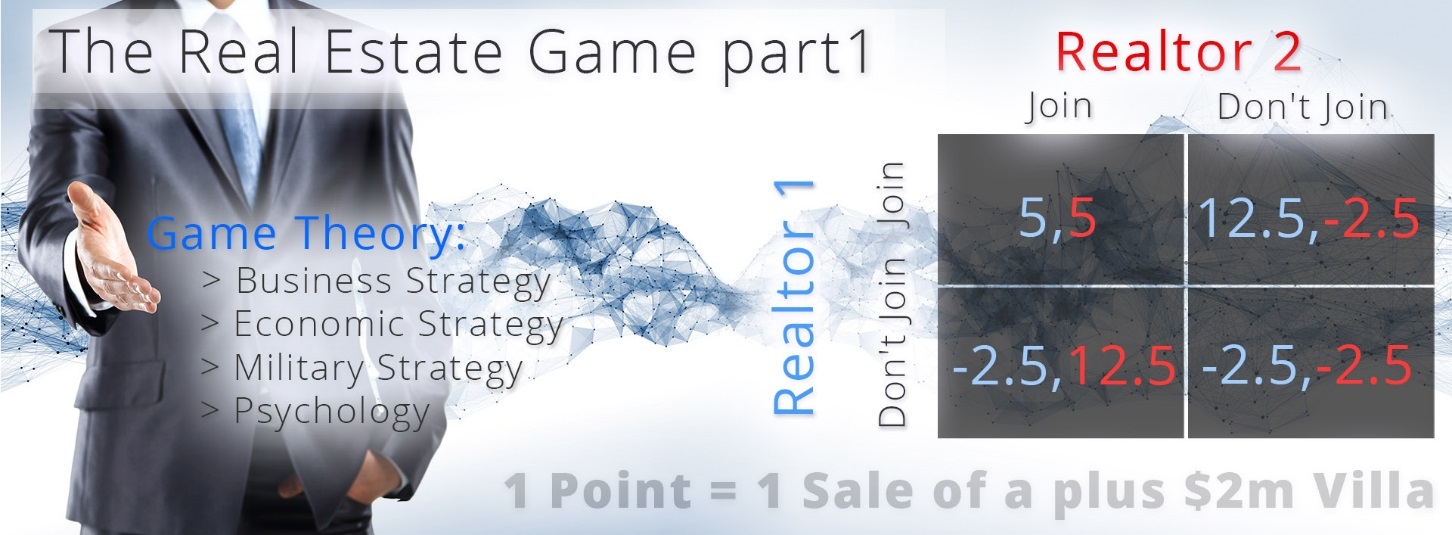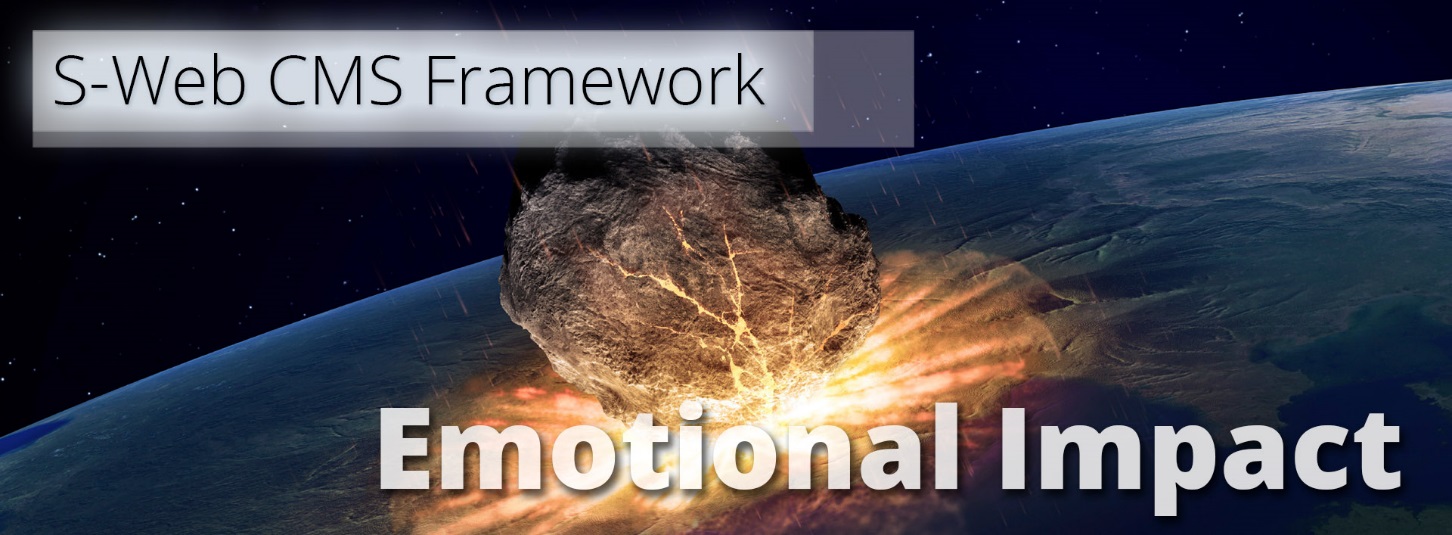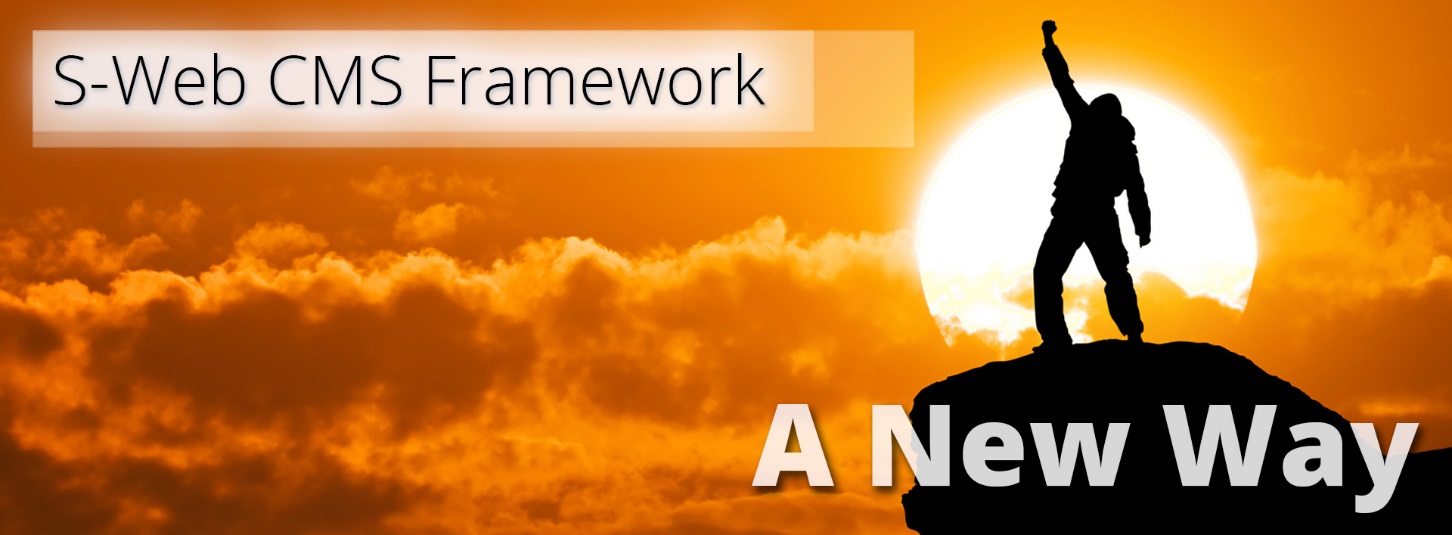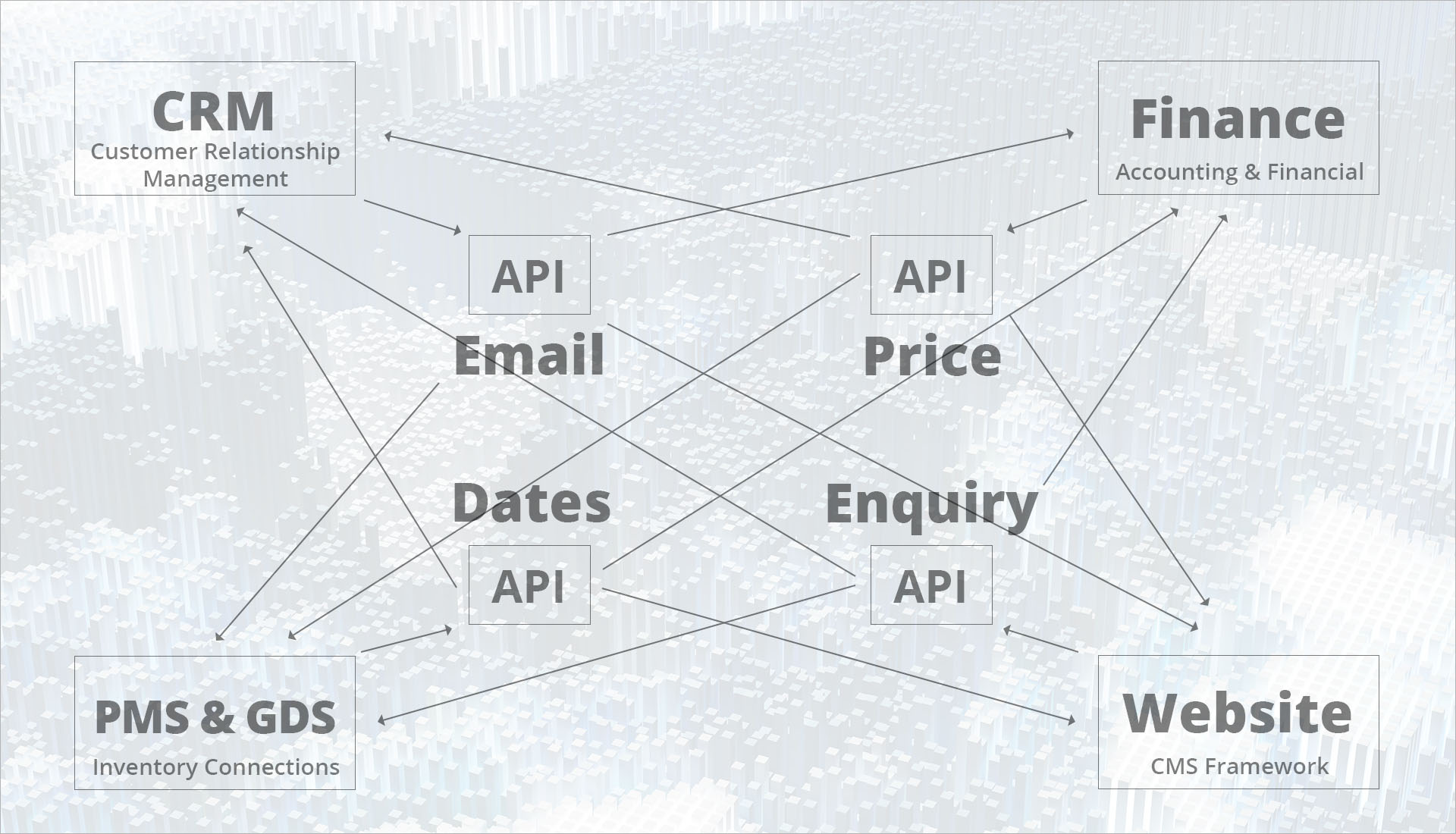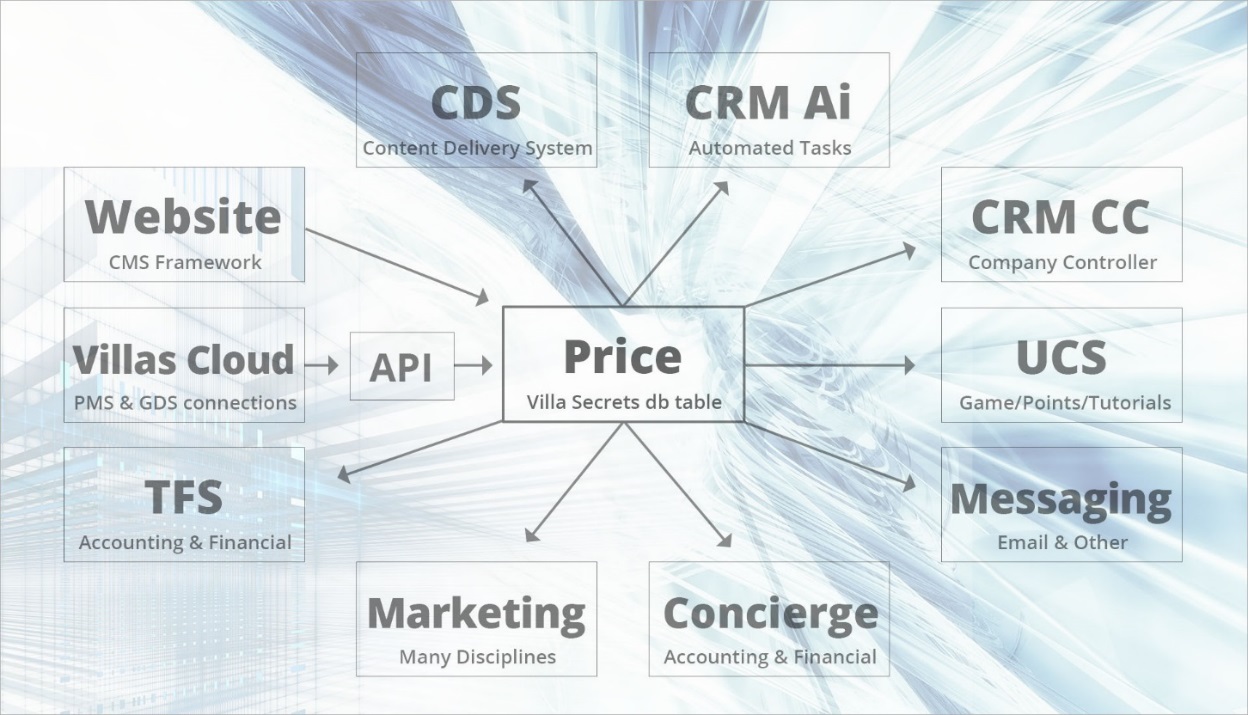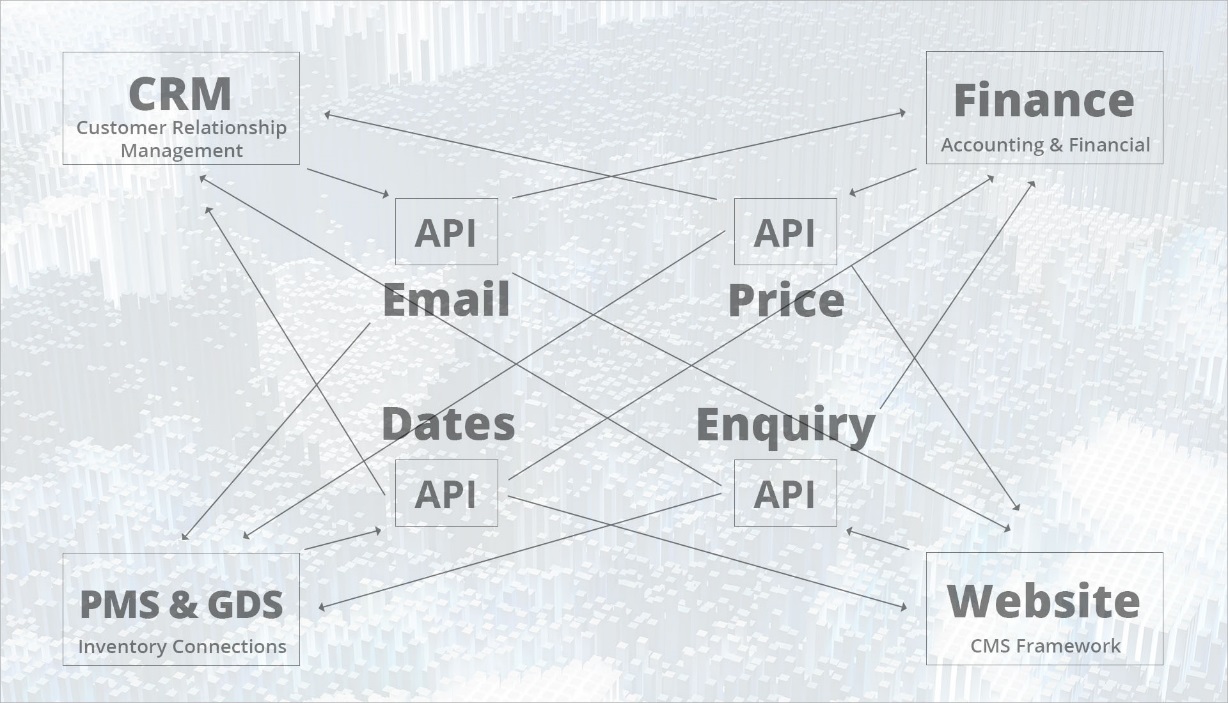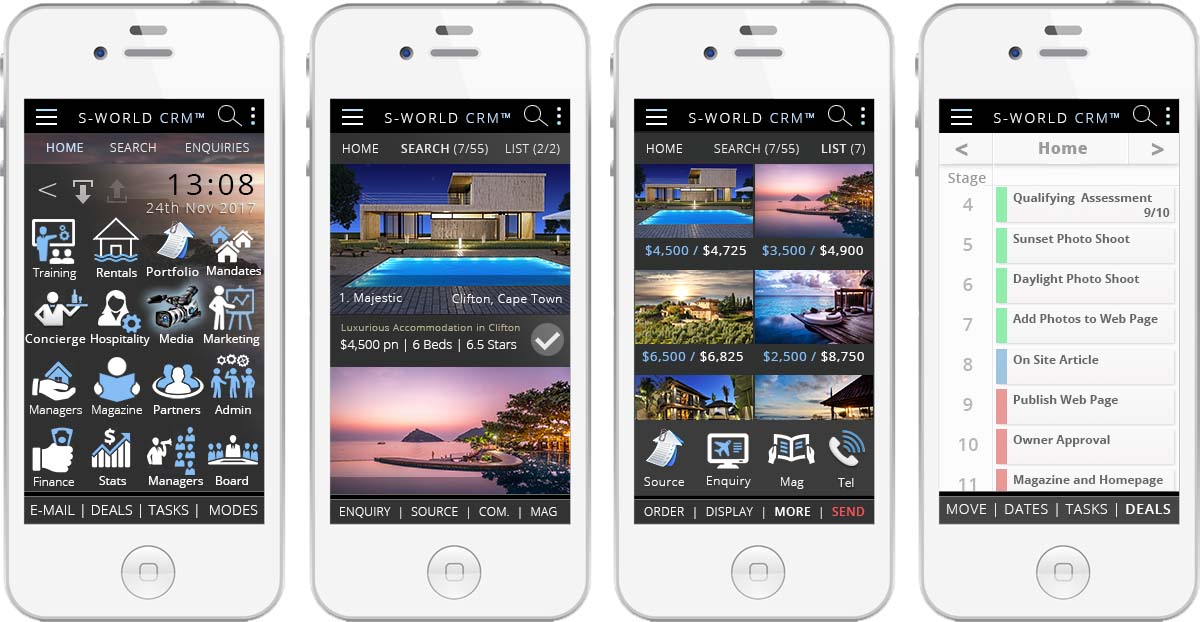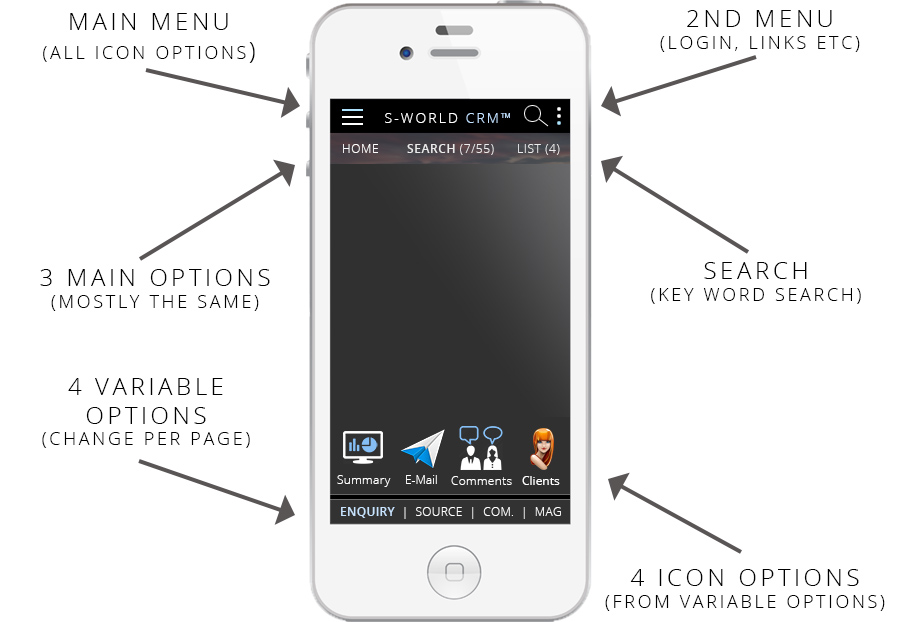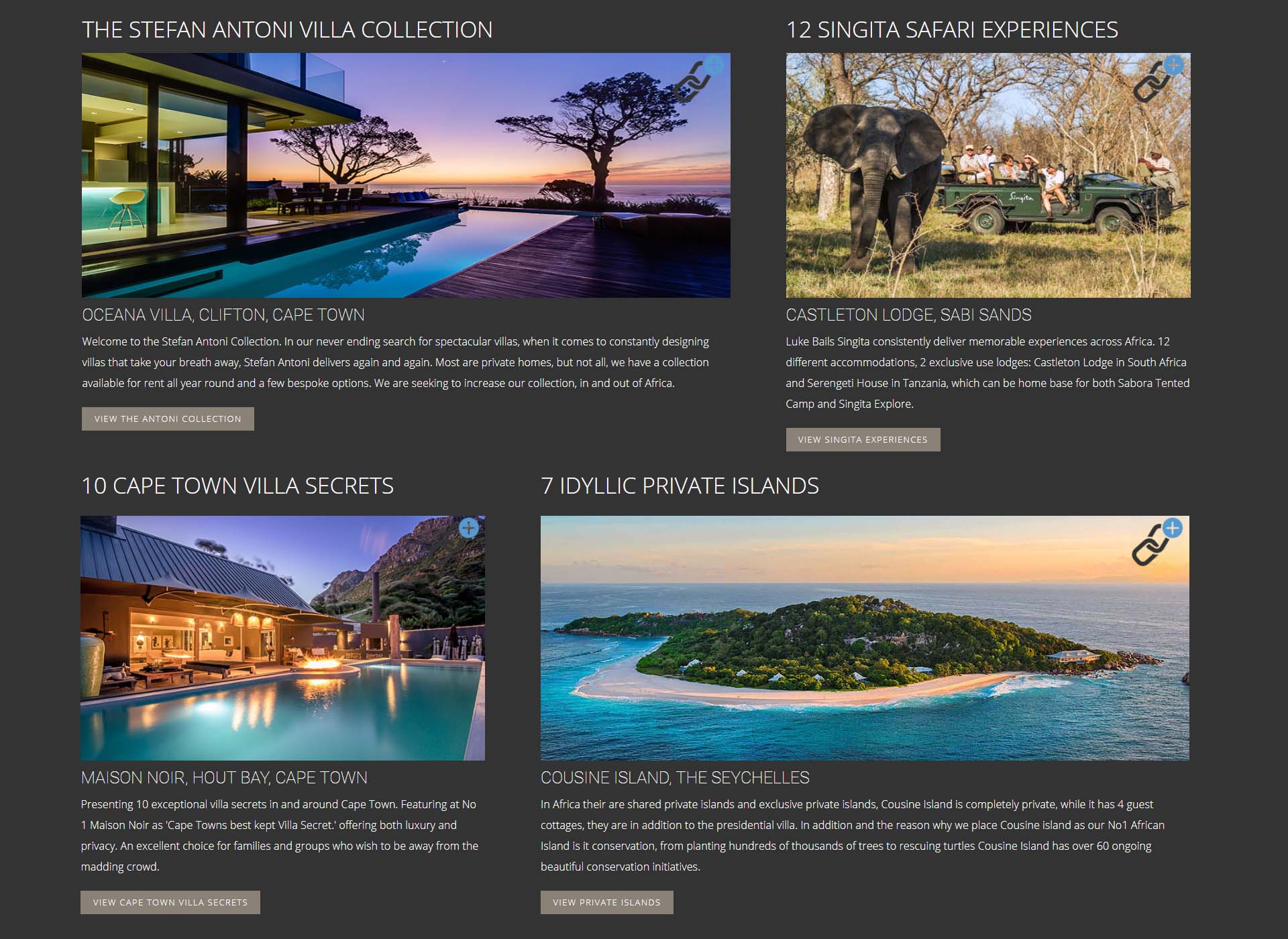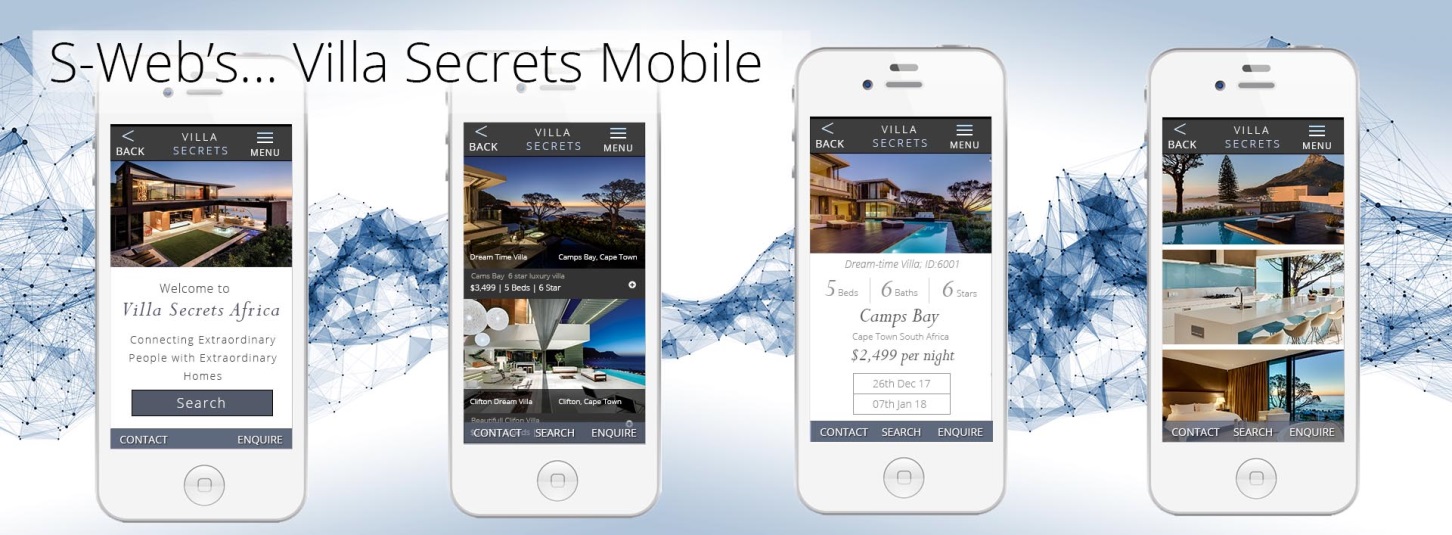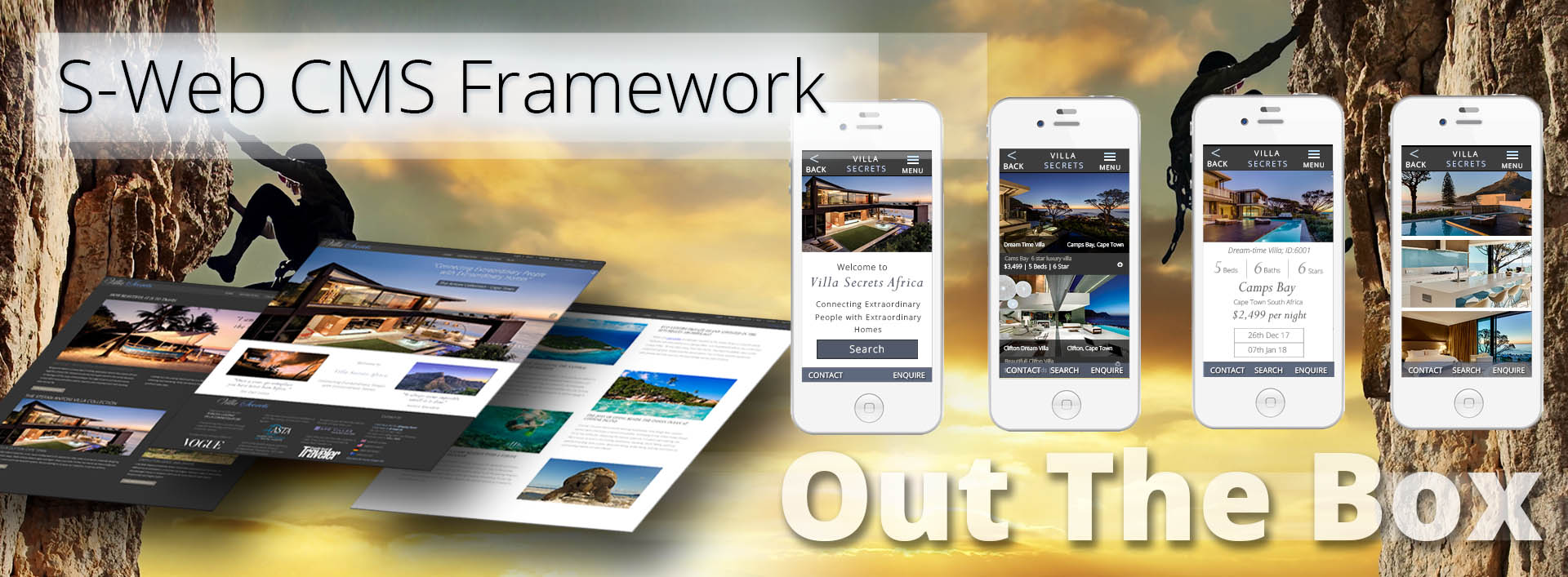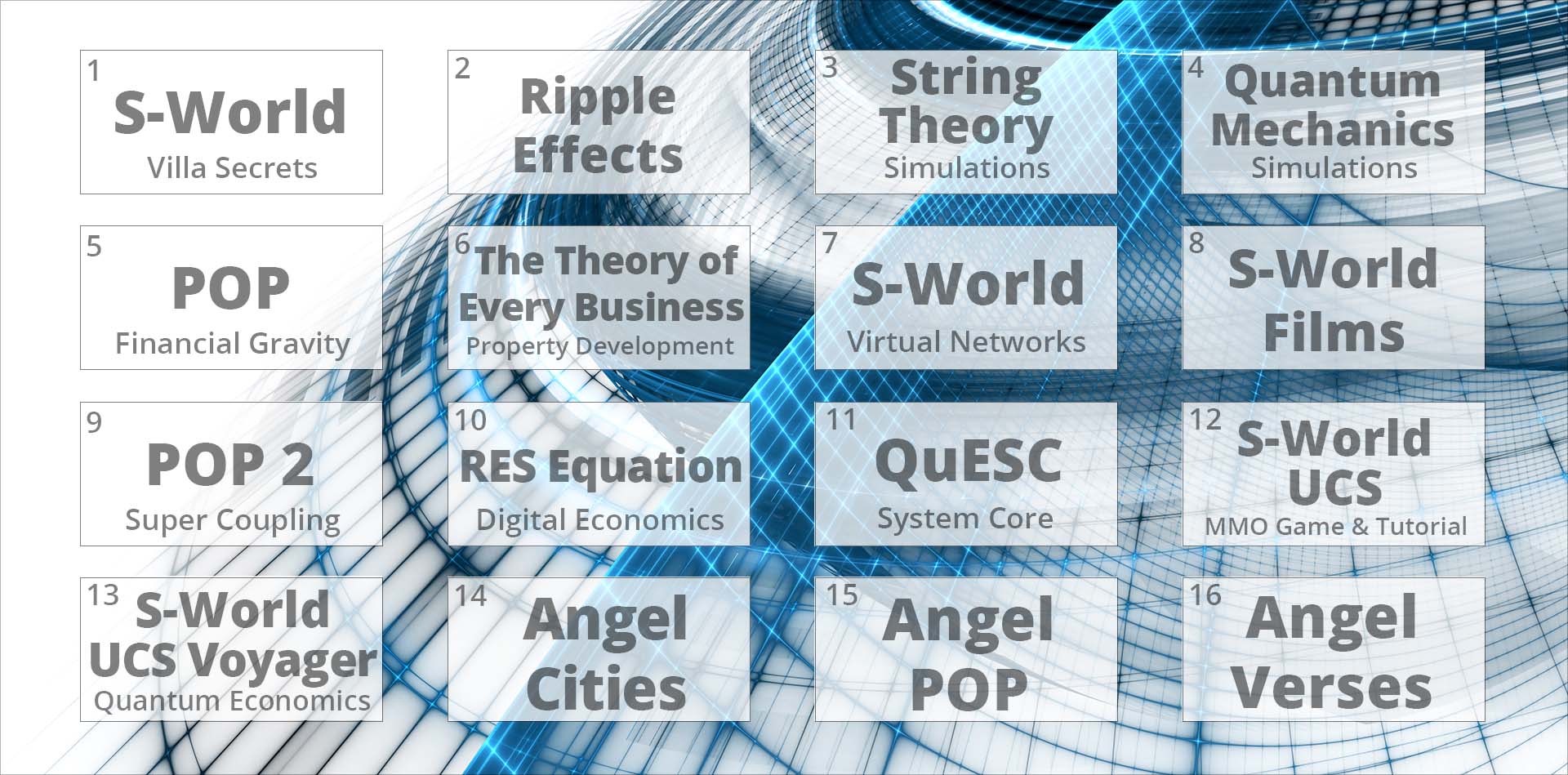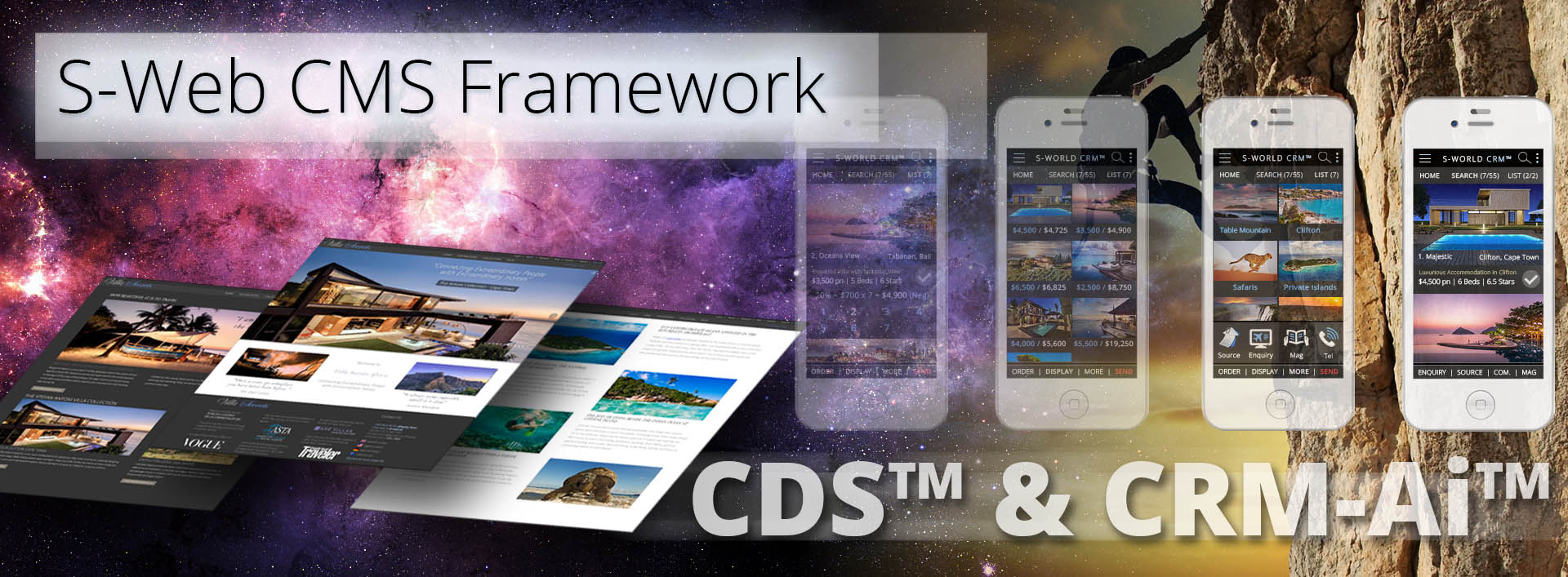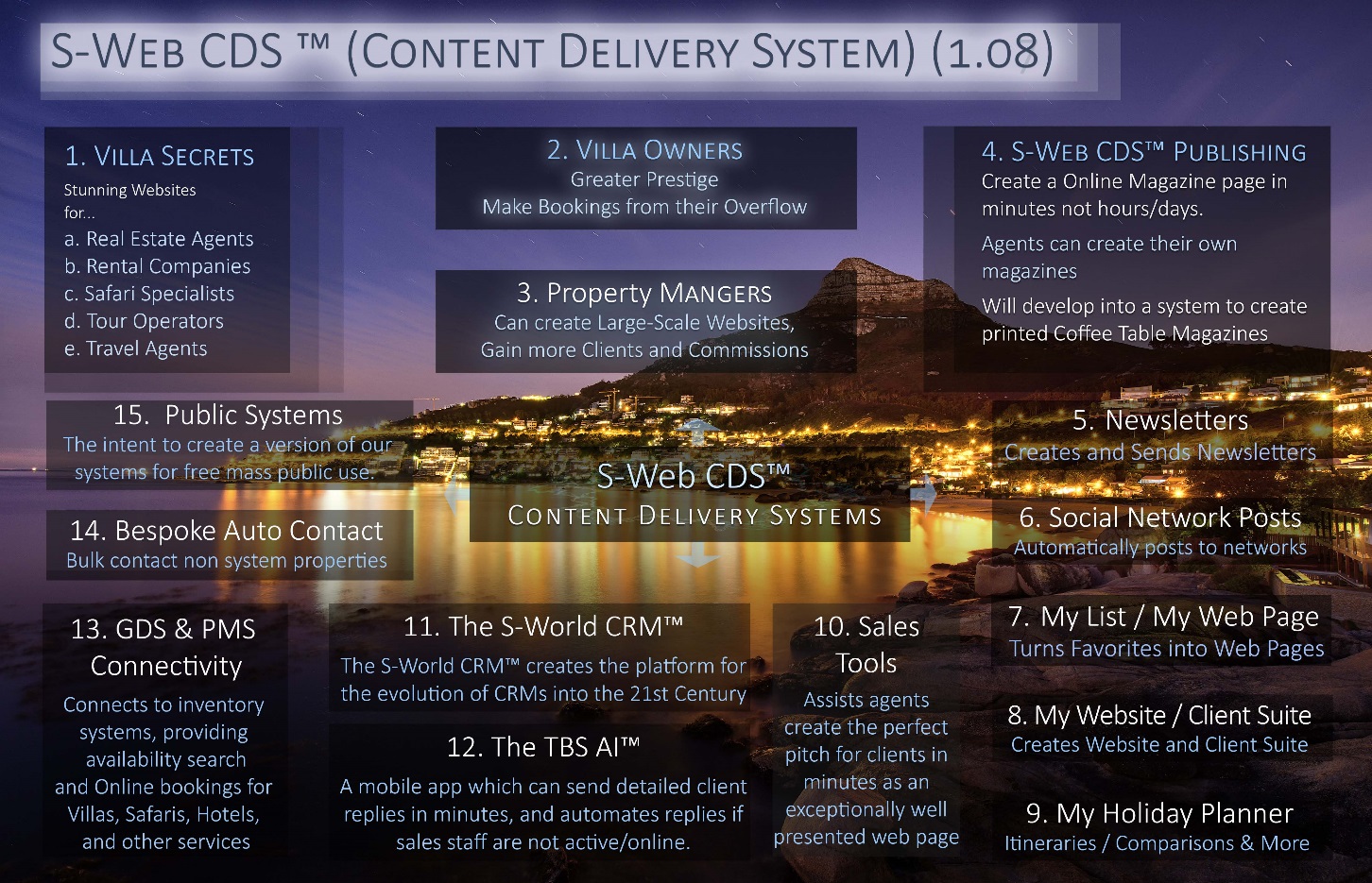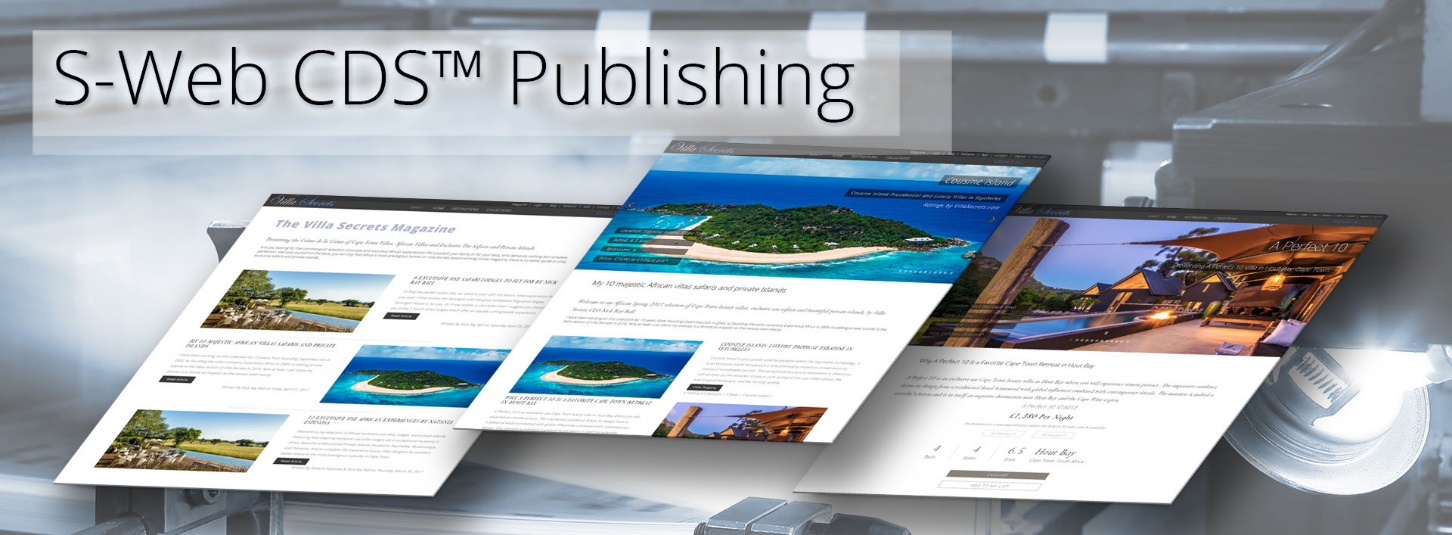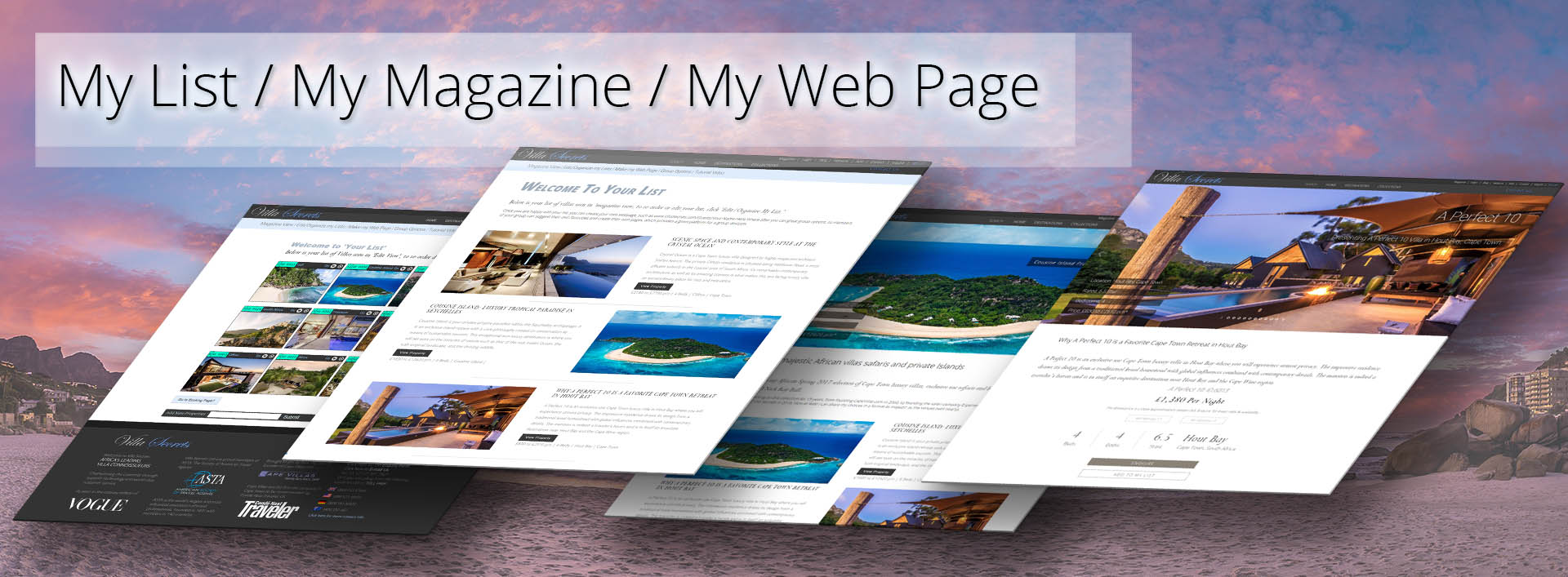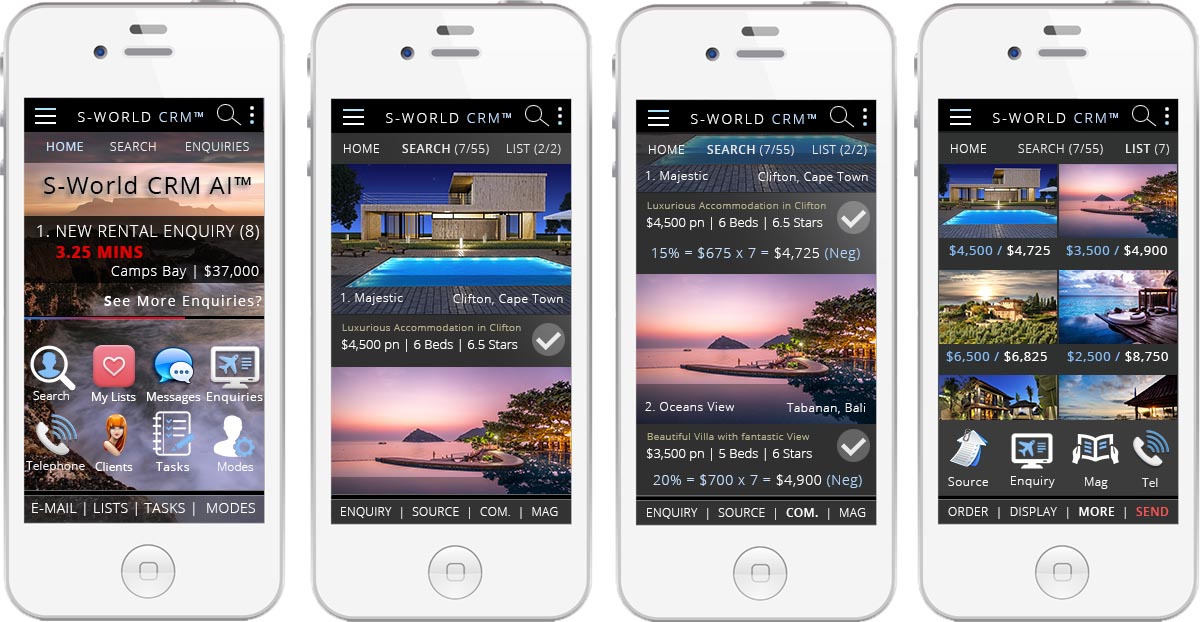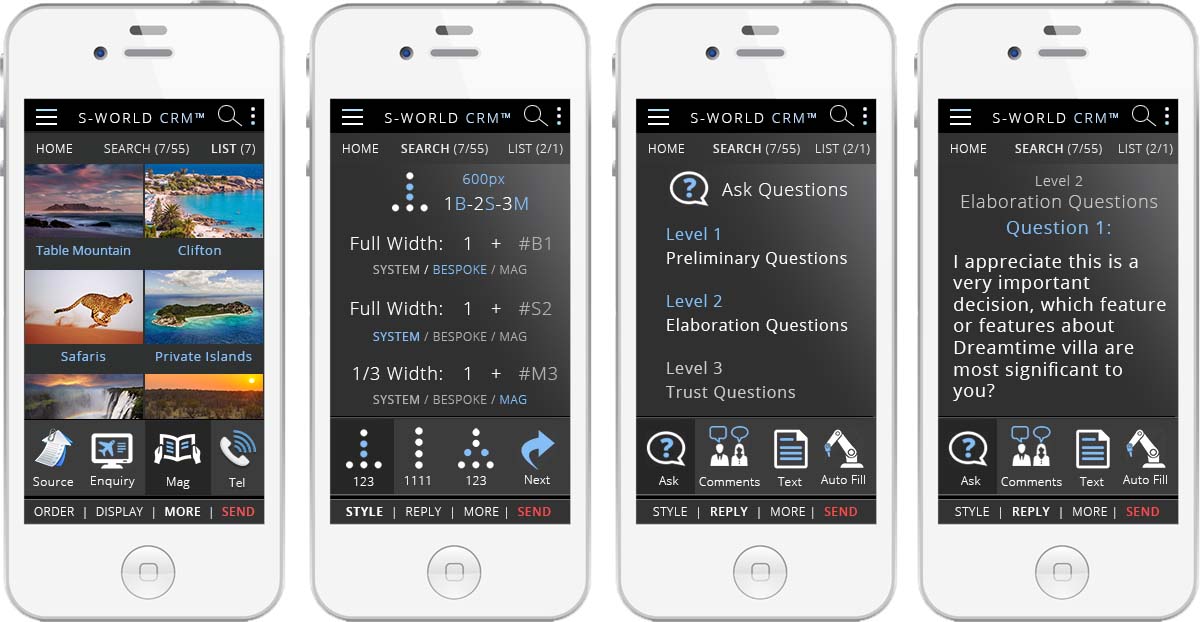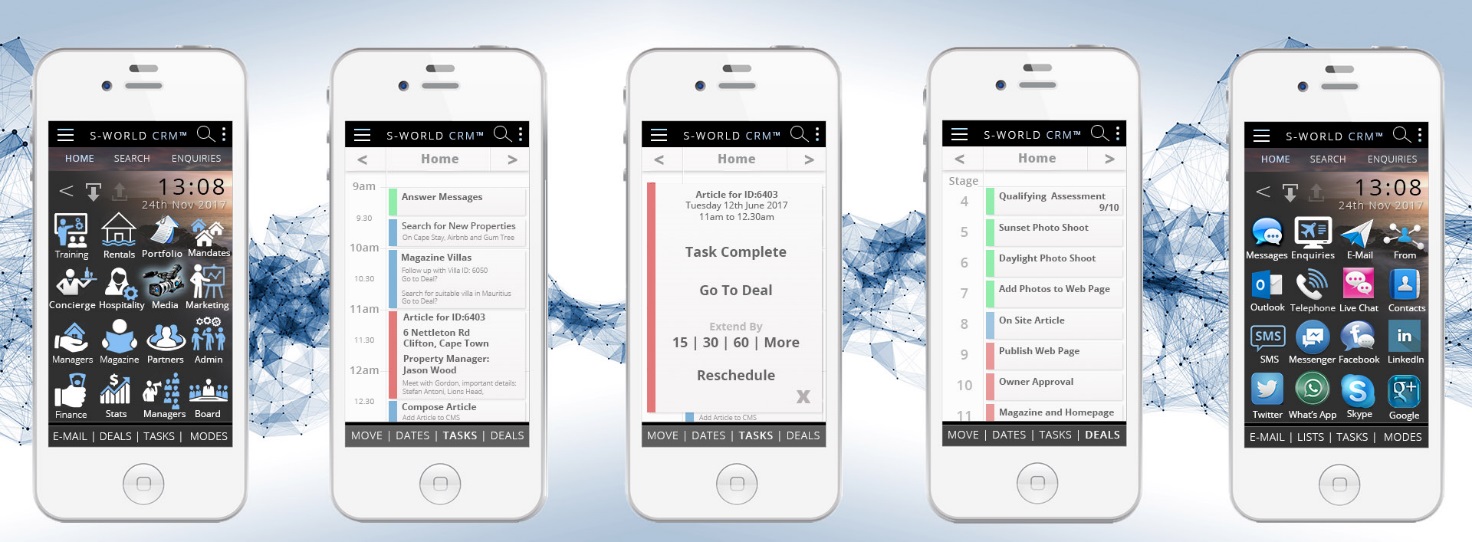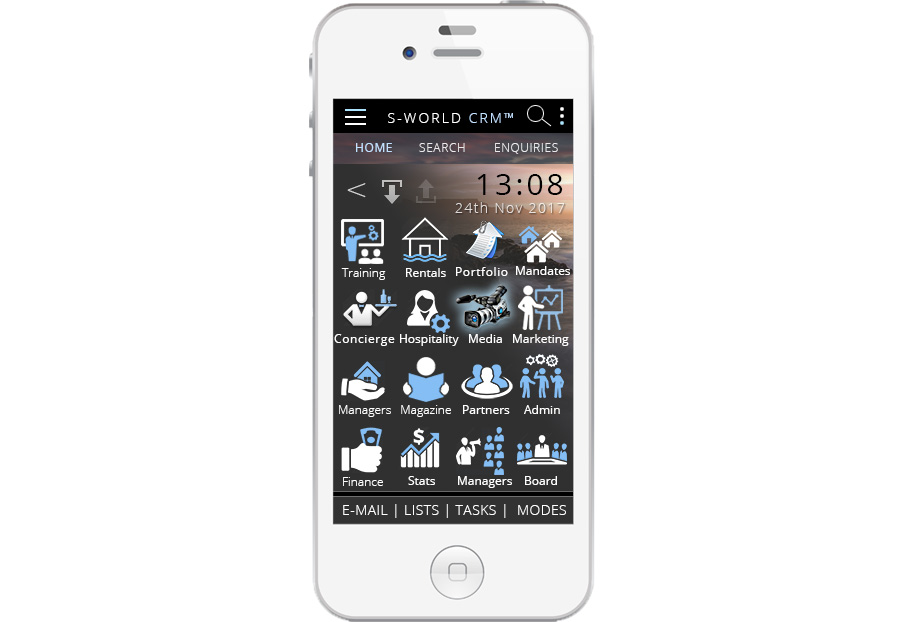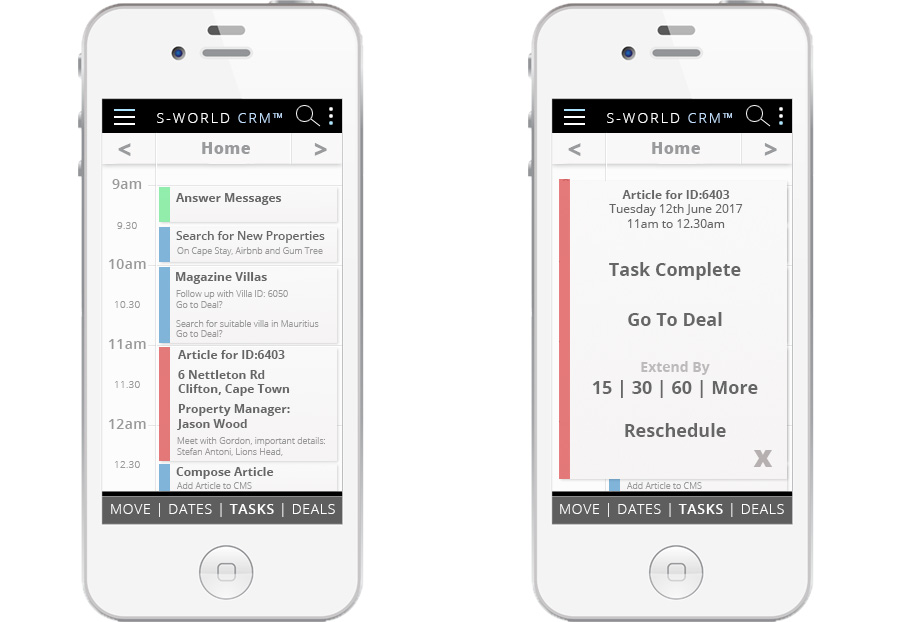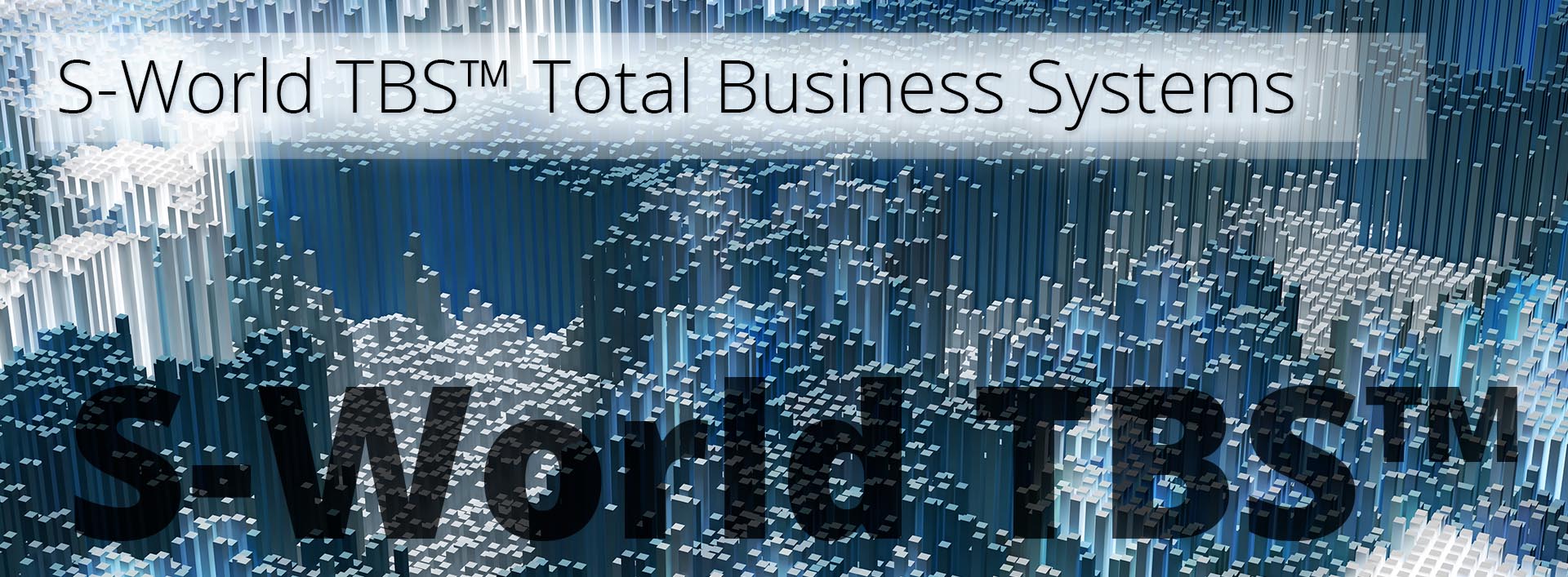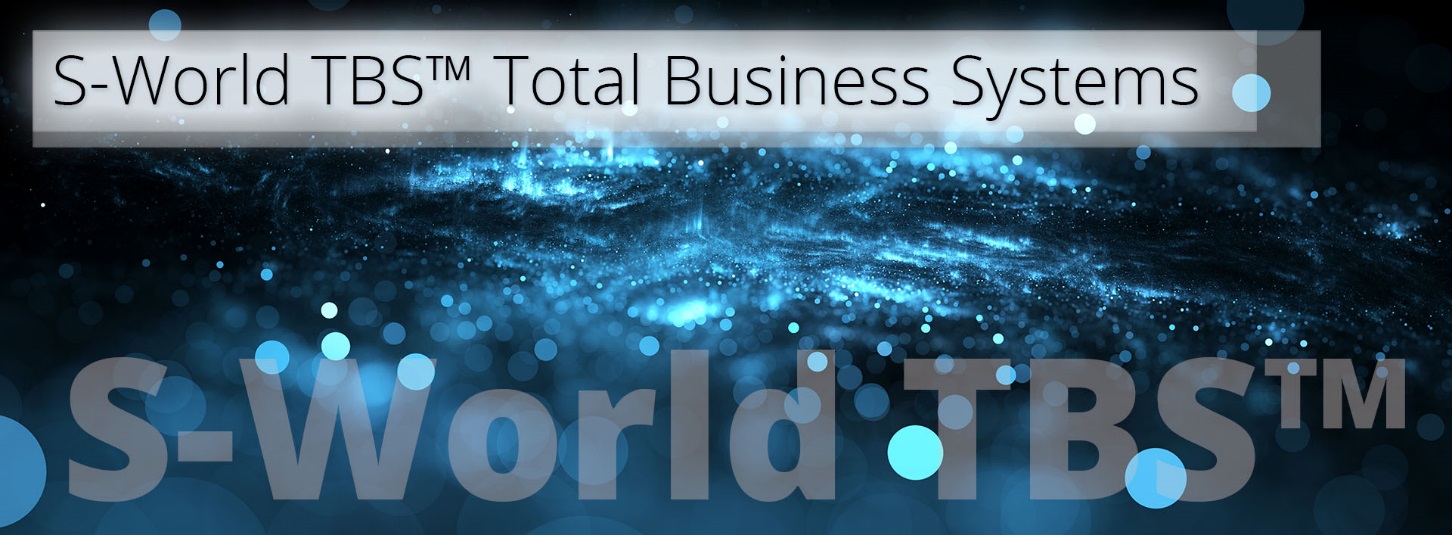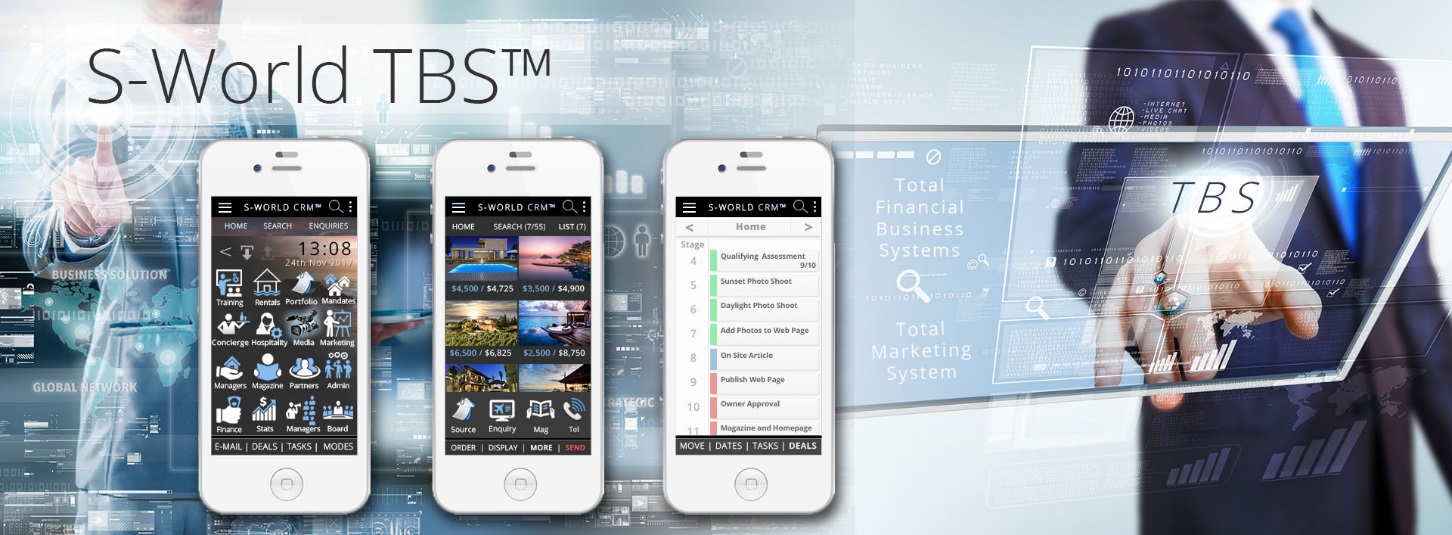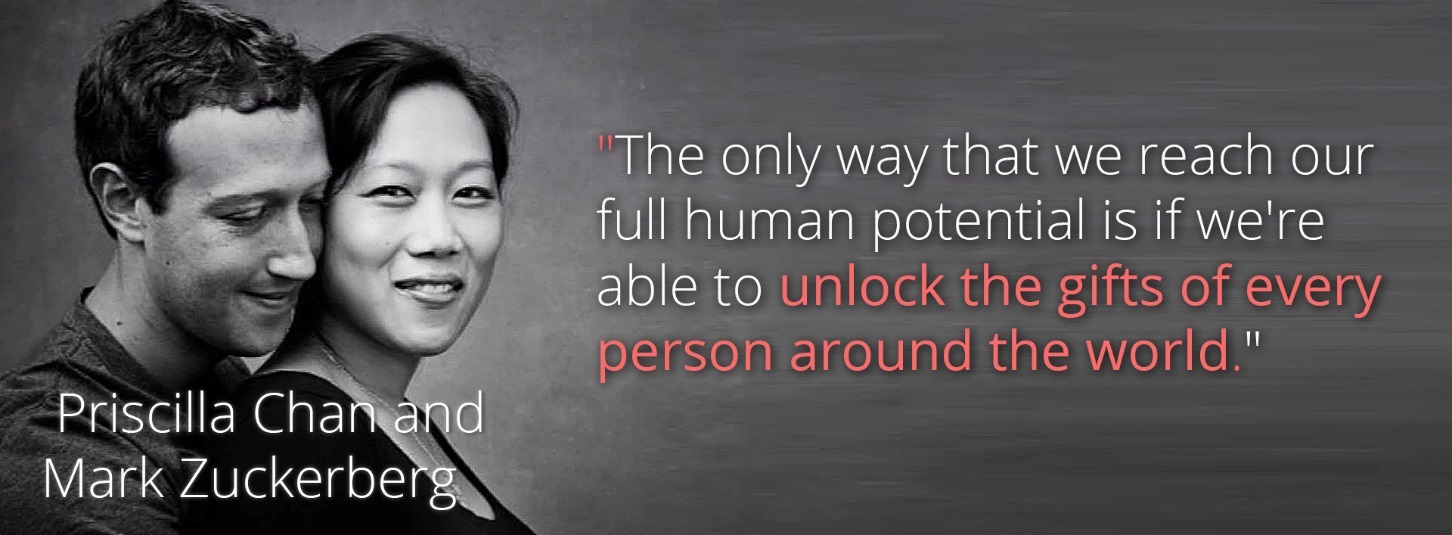s-web-cms-framework-step-6-our-solution
The Challenger Sale Step 6. ‘Our Solution’
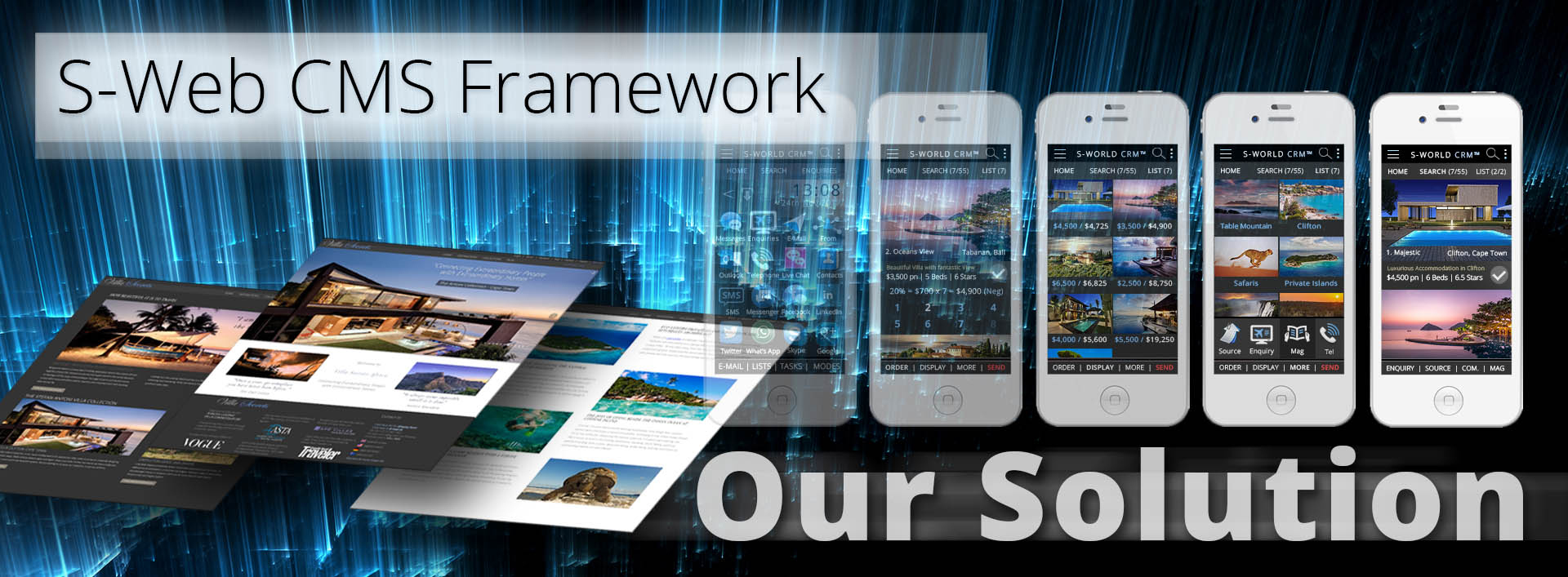
Dixon & Adamson (The Challenger Sale):
Finally, demonstrate how your solution is the best one out there, now you lay out the specific ways that you can deliver the solution better than anyone else.
Our Solution Index…
-
S-Web CMS Framework Part 1
-
S-Web CMS Framework Part 2
-
S-Web CMS Framework Part 3
-
S-Web CMS Framework Part 4
-
6. S-Web CMS Framework Part 5
S-Web CMS Framework Part 1
a. A Combined Website and Software Framework
“To create truly disruptive complex systems without creating overly complicated systems; if your software is primarily to support business gained from your website, your software should be part of your website contained within a single web framework.”
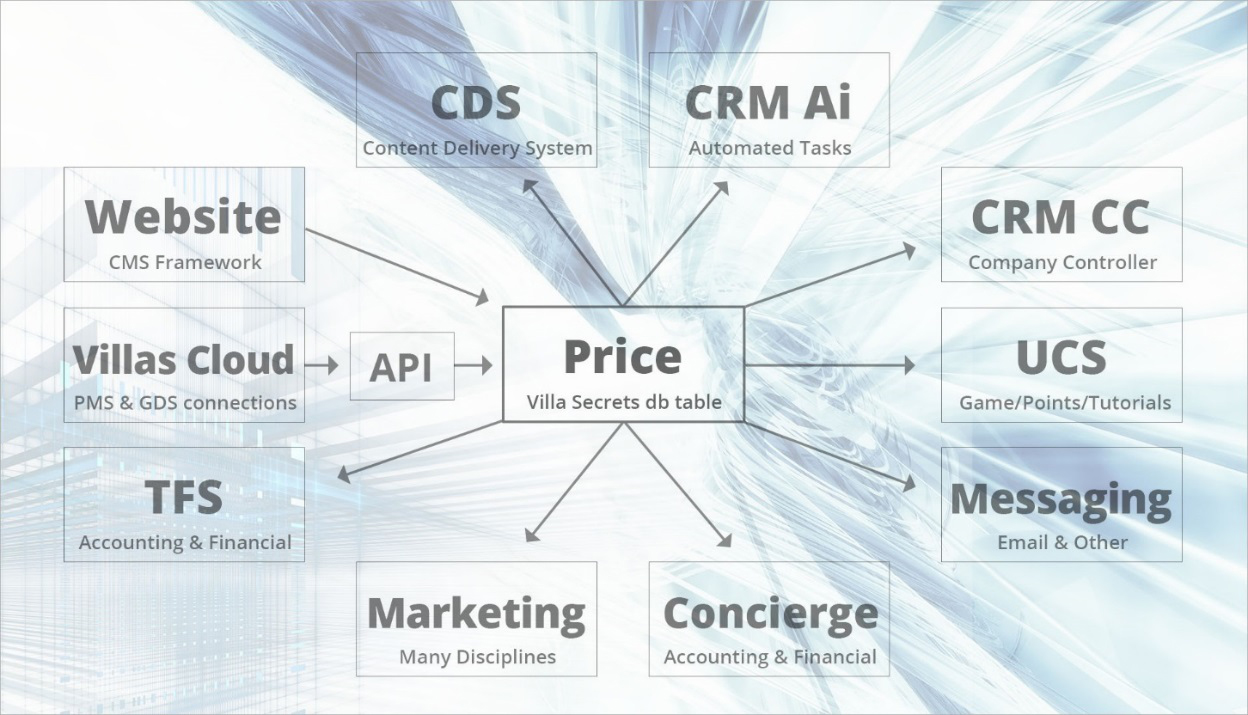
Above, we see a graphic with 9 different Villa Secrets software systems intrinsically connected to the CMS web framework (the Website). On which we have isolated a single dataset the ‘Price.’ We can see how much simpler it is to develop this system, relative to using many software components strung together by APIs (data connections between 2 or more separate software items or websites) that create multiple data sources. And as seen below, in which we only show 3 software items which are already more complicated.
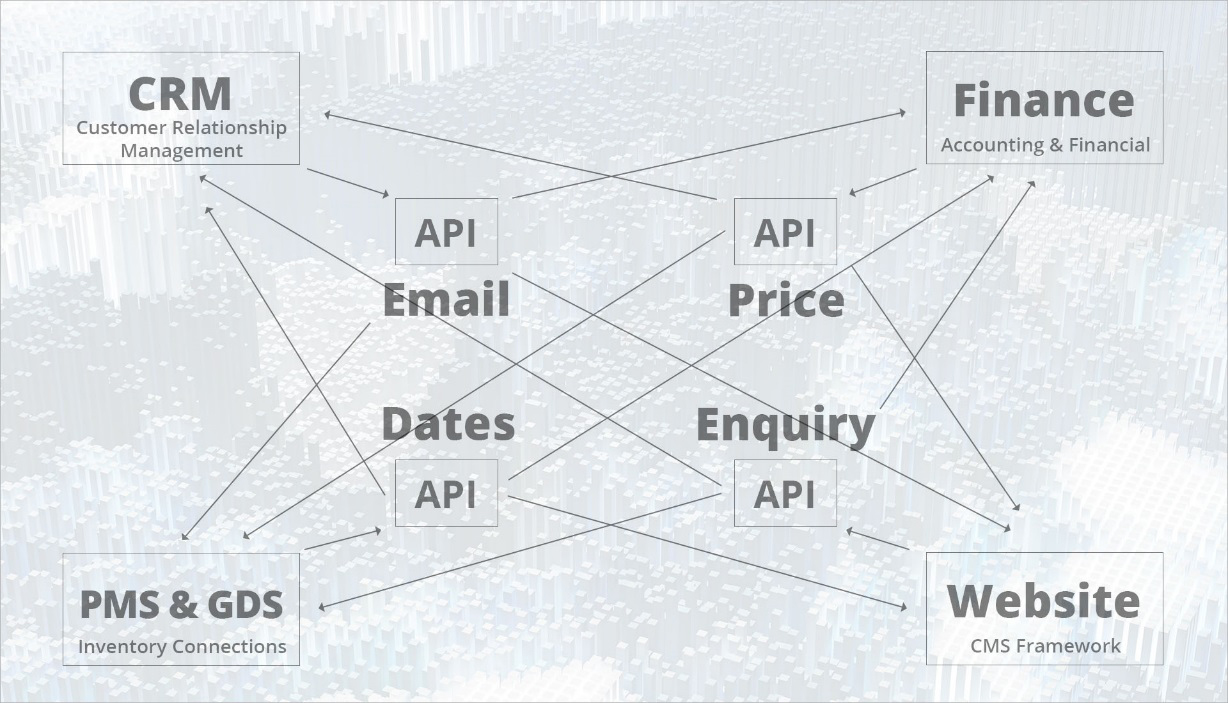
Of course, the above is an incredibly oversimplified version of both systems, as there are thousands of different database tables for this function and that function. A company that really knew their stuff could take every possible data set from each API and add that to one single master database. But that’s a lot of organization and time and even then, one is limited to only data sets that are available from the API in the first place.
Whilst very technical, the above helps to explain the trouble IT companies have in creating useful systems, which helps explain the statistics from the Corporate Executive Board’s Sales Executive Council. Who, if we remember, serve more than 200,000 business leaders across roughly 4,800 organizations in more than 50 countries and who say:
The CIO Executive Board found that only 26% of business leaders rated their IT departments as effective.
76% of staff disagreed with the statement: “Has their job performance improved due to a new system delivered by IT.”
However, working our way (the Villa Secrets S-Web and S-World way) makes the creation of truly complex systems possible, without being truly complicated. If one has one central database that all systems fetch data from, we avoid the law of diminishing returns that would grind systems made up from different items of software to a halt as they become massive.
This does not mean that we don’t use APIs (data connections between 2 systems), for instance Google Analytics and just about every PMS (property management system) and GDS (global distribution systems). However, for all functions that provide data that we could not have gotten or created ourselves, such as CRM data (customer relationship management), accounting data, marketing, hospitality & concierge software; we create the systems we need straight into our core system, the S-Web Framework.
S-Web CMS Framework Part 1
b. We work one industry niche at a time
Large scale CRMs (customer relationship management) such as Salesforce are not dissimilar to jigsaw puzzles with thousands of pieces, of which some pieces are connected to create a solution. For most CRMs, the name ‘customer relationship’ takes a second place to the sales process of selling to the customer and monitoring of the sales person by management to make sure they are selling to the customer; with the only ‘customer relationship’ function being to send a bunch of follow up emails that most customers would prefer not to receive in the first place.
In contrast, if we go back to the first S-World integrated software design in 2011 created as an investment option for VIRGIN www.s-world.biz/TST/The_Virgin_Business_plan_in_Retrospect.htm, we see that one of our CMSs primary purposes is to deliver gifts to clients. A system now supported by the Villa Secrets coffee table book which will barter product placements and adverts from leading luxury brands like Bulgari for gifts (such as handbags, perfume, and other items) that we give to clients on arrival and send to them on special occasions such as anniversaries and Christmas after their stay, providing a truly effective form of remarketing and customer retention.
However, CMS or Sales Tool:
“We make our websites and software for one industry niche, whereas most CRMs create a product for every business on the planet!”
Ask the C-Suite managers, or any developer at Salesforce, Sage, Zoho or any popular CRM if they thought they could make a better version of their software. If they made a system for a specific industry, or better still a niche within an industry and they would all say…
“Well of course…”
It’s far, far simpler to create a CRM specifically for an industry niche than it is to create a system for all possible businesses. Not only because in doing so one can throw away most of the clutter, but because one is making a system specifically for a single purpose that one can get very detailed in the psychology and neuroscience of the communications back and forth.
For instance, we can include items that are not included in all industry CRMs such as 2nd and 3rd level questions and prompts; which in ‘The Science of Selling: Proven Strategies to Make Your Pitch, Influence Decisions, and Close the Deal’ David Hoffeld explains are a key way to influence a potential client to book or buy, as Hoffeld reveals:
“These powerful questions have been analysed in numerous recent scientific studies. For instance, a study at Harvard University revealed that answering second level questions which prompted participants to state their opinions increased neural activity in the areas of the brain associated with reward and pleasure! These good feelings caused a change in the brain that naturally enhanced the participants emotional state. In other words, customers enjoy answering second level questions.”
S-Web CMS Framework Part 1
c. We work ‘Mobile First’

In the spring of 2015, we added a JQueryMobile website to the then prototype Villa Secrets website. You can see the mobile version here http://m.villasecrets.com (please view on mobile and note its only 80% complete). The reason we did not complete it was that in our ambition to create an ‘out the box’ web product, working this way made life twice as hard as we effectively needed to create 2 websites. So, if we wanted to create 64 versions of the Villa Secrets web framework, each on a different domain, we would need to create 128 different websites.
In addition, we saw warnings from Google explaining that working in this way was not good for them, as with two webpages for each page (http://m.villasecrets.com and https://www.villasecrets.com) a link to a page on desktop would give no power to the mobile version and vice versa. Another reason we stopped working this way is because each time we made a new page for desktop, we needed to make a new page for mobile. And as we wanted to add many different pages, we could see there would be a lot of work to do, and it would be better if we created our own mobile framework and work ‘Mobile First.’ And in doing so, we own our own framework and sow the seeds for a product that can be created instantly at the touch of a button.
So, we decided to work from the JQueryMobile design and completely recreate the desktop version, which was a brave decision as we knew it would take at least a year to create, and so we would lose a year’s revenue. But knowing this was the right decision, we decided to gamble all the additional money created from the www.cape-town-luxury-villas.com prototype. And so, at the beginning of Autumn 2015, we added 2 more programmers, a top-level HTML 5 designer and a copywriter.
However, within just a few days of the new team starting, a long-term back injury reoccurred and limited my ability to type instructions for the team, who I communicated to from London to India via Skype. This event demanded a change from the development plan and was very significant; and also, rather odd that as soon as I made the change, my back got better and has not troubled me since…
This game changing decision was to learn WordPress, which I had seen catching up and beating my stable tool for web design since 2000, ‘Adobe Dreamweaver.’
Without the ability to communicate at pace with my team, I suggested that we stop the plans I had made for us all and instead we were to all learn WordPress (well all of us but the designer who already knew it).
Fortunately, the very first WordPress lesson I found online was a very detailed three-hour tutorial presentation by Ferdy Korpershoek on the Enfold Theme. Here is Fredy’s video https://www.youtube.com/watch?v=tpMof6O1QNw and here are various demos of the theme http://www.kriesi.at/themes/enfold/. And as you look, you will see how this WordPress theme helped mould the look of our current website design, www.villasecrets.com and in particular the HTML5 animations.
After a few days, my back was better. But having seen the design power of WordPress, we just carried on, making various test websites, and testing the database capabilities before integrating an Enfold Theme WordPress website into the Villa Secrets website as a separate blog site http://blog.villasecrets.com. And so, for a while we just experimented with WordPress and the idea of a hybrid WordPress vs Villa Secrets framework website. Until we came across the problems mentioned in the previous steps, and (in particular) that we could not easily add data from our MySQL database to the WordPress SQL database without creating specialist WordPress plugin each time, which would take a long time. Indeed, we would need a dedicated full-time programmer just to make the plugins.
It was at this point that the decision to completely remake the desktop design came about. And as we were redesigning the entire website, why not do it in a mobile first way? The first task was the navigation which required fewer options; and once created, we proceed to make the mobile pages and desktop pages at the same time, using both our WordPress experiments and the JQueryMobile site as a guide. And 21 months later, we can see the mobile first Villa Secrets website www.villasecrets.com.
But this is only half the story, because having seen the merits of mobile first web design, when it came time to create the designs for the CMR and other software, we again started with the idea created in desktop, but then designed first for mobile, and in particular the navigation and workflows.
For a truly disruptive mobile experience, we needed the mobile version of the CRM to have the simplicity of a game or a well created APP. So, before considering any on page input, we needed to create a simple navigation system.
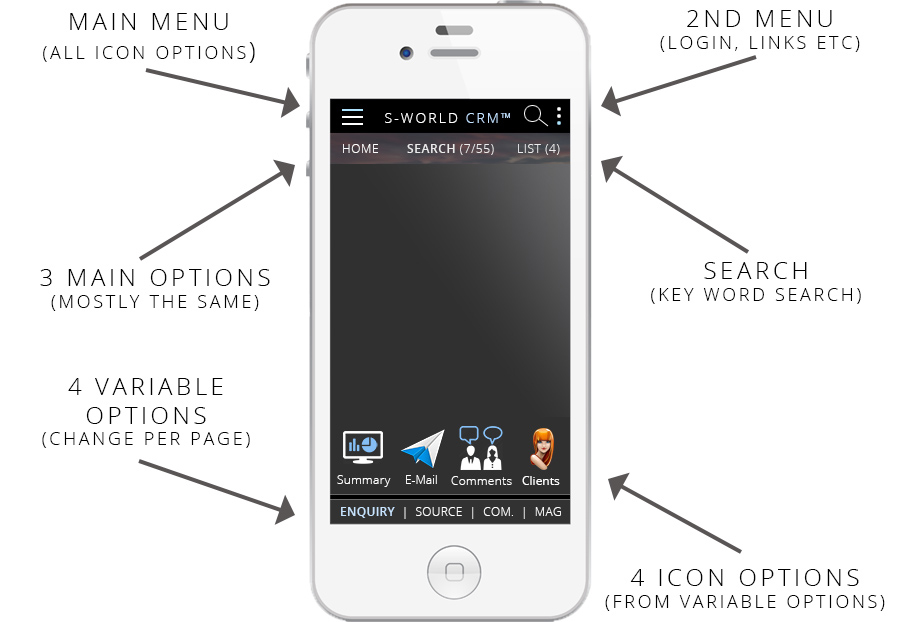
Above, we see within our mobile menu, we added top and bottom navigation. The top will mostly stay the same, but the bottom will change for each function, and is supported by 4 icons that also change. This creates a total of 48 different ‘quick tap’ options available for each individual page. Which is a lot and, as far as we know, a unique way to navigate on Mobile, because with 48 quick tap options that are instinctively arranged, one creates a very versatile base from which to create complex websites, software, games, and apps.
S-Web CMS Framework Part 2
a. S-Web Super Simple CMS

There are millions of companies making ‘do it yourself websites,’ but the S-Web framework is different. Instead of making individual pages, S-Web users start with a complete website for users to replace or update the content on each page, with no widgets or fuss. An example of this is our homepage www.villasecrets.com, which can take less than 10 minutes to create.
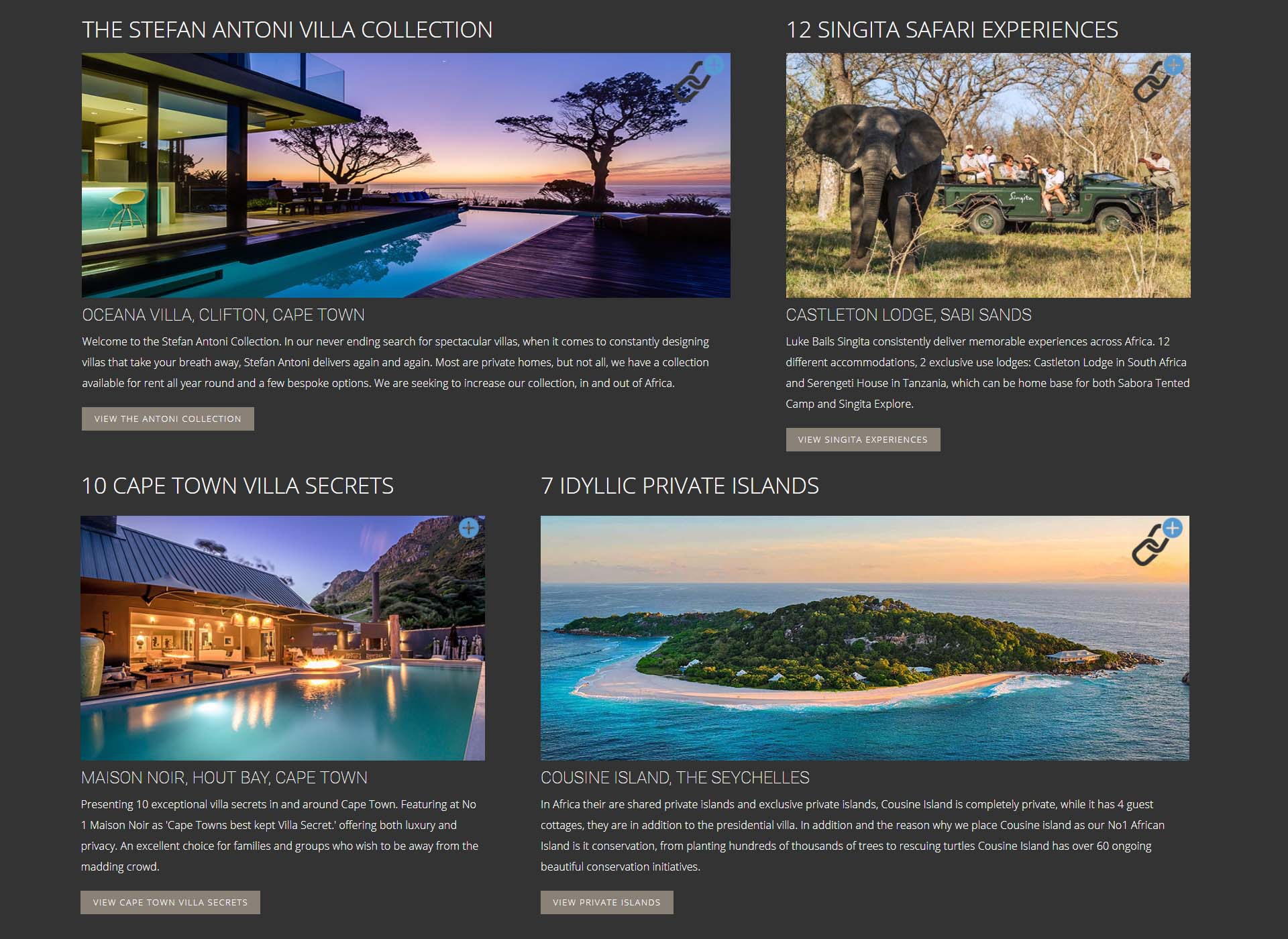
Above, we see part of the homepage CMS, which for anyone who has ever used WordPress or other CMSs will look very unfamiliar. There are no options to consider other than the content, and the little link icon at the top right of every picture.
Clicking on this link lets you add the property or magazine article ID. And when entered, it changes all the entire section adding a new header, photo, location, 60-word description and the call to action button, ‘just like that!’
Or one can add a new photo and write one’s own header and descriptions for each part, or simply edit any section.
It’s that’s simple!
And because it’s that simple, one no longer needs a web designer at all, beautiful complex pages can be created by the most junior of staff. In fact, you could even ask your 7-year-old child to create a homepage that would still look professional and engage the public.
Skipping back in time a little, our individual villa pages which paved the way to the homepage CMS, were initially forged as a response to web developers across the world raising their game and creating increasing more attractive websites. The only way to combat this was to raise our game, substantially. One idea was to create individual villa pages that looked like homepages and, working in WordPress, we created pages like this: http://blog.villasecrets.com/blog/cousine-island-villas-seychelles.
Whilst this and the other individual product/villa pages we made were a great improvement on any other travel or real estate website we could find and proved very popular with guests and villa owners; each page took about three to four days to create, and as such were expensive. So, we created a super-fast CMS (content management system) for our copywriter and photographer to use. And in so doing, after they had written the copy and chosen the images, adding the content and creating the animated image slider at the top of the page was down to a dozen or so minutes.
Here is an example www.villasecrets.com/Villa/North-Island-Villa=6061 which is superior to our original WordPress designs, and better than the most websites homepages. Which makes an impact in the high-end villas market as looks count, both for clients looking to go on holiday and equally the owners and managers of the villas, safaris, & private islands.
The final essential component to any website is how one presents products/villas after a search is performed. One can see our search results page here: www.villasecrets.com/Best-Of-Africa, this page gets created automatically via the photos and text in the product pages, and a CMS page that changes the order of the villas.
We are creating a ‘super simple’ ‘on page’ CMS for every page. In fact, most pages are already done, we just need to do the contact us and various ‘about’ pages. Then after, as we add new pages such as Owner & Property Managers pages or the Client Suite, we will create the page and CMS together.
Does it work in mobile? Yes, beautifully and in fact better than both our original JQueryMobile and our WordPress mobile webpages, which got confused by the magazine style layout and ended up showing the pictures in the wrong order. Which yes, could have been fixed in the CSS editor, but not by anyone who was not skilled at CSS coding.
S-Web CMS Framework Part 2
b. S-Web’s Villa Secrets Mobile
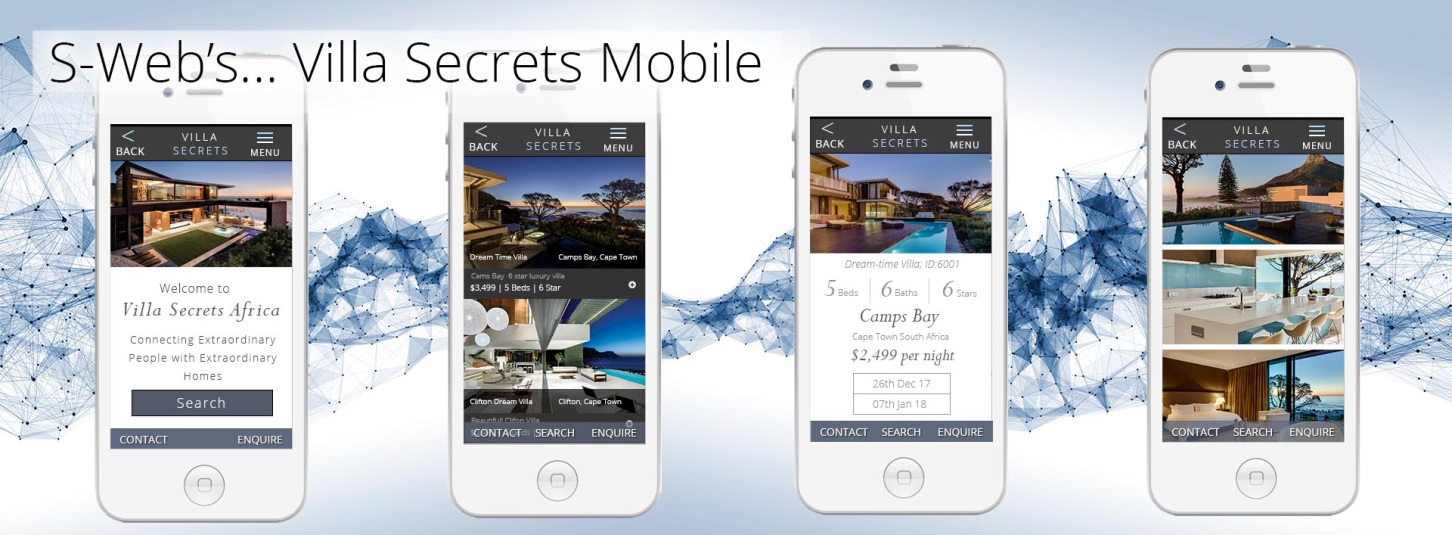
S-Web Mobile, the mobile website that looks and behaves like an App.
When it comes to the best website design, with so many different designs, there is no clear winner. However, in the land of mobile websites, there is far less competition, we are positioned amongst the best in the world.
There are many mobile-friendly sites made from WordPress. But WordPress is a tool for making smaller websites and not practical for big database driven CMS projects.
Google have warned that they will penalize websites that are not mobile-friendly. It’s only a matter of time until they do, because presenting poor mobile pages create a bad user experience.
Search engines aside, mobile usage has overtaken desktop. To have a site with a poor mobile presence is to say goodbye to half of one’s customers. Mobile is not the future of the web, it is the right now!
As you can see, our mobile product looks like an App and has instinctive navigation. It does not have all the functionality of the desktop version, instead, we have taken only the parts that make sense to see on a mobile, as we seek to make both the simplest and most attractive mobile real estate and travel user experience.
But note the only reason we can do this so effectively is because we worked ‘Mobile First’ from our JQueryMobile site to our desktop site, and then created our mobile site responsively from the webpage. Note in particular the on-page drop down navigation that is the same on both desktop and mobile.
Whilst the mobile page and the desktop pages look different, they are both the same page, which in SEO (search engine optimization) is an improvement on mobile frameworks like JQueryMobile; which demand the creation of new websites specifically for mobile use, which loses any link power attributed to the original desktop page in mobile searches (or vice versa).
S-Web CMS Framework Part 2
c. S-Web ‘Out the Box’ Complete Website Builder
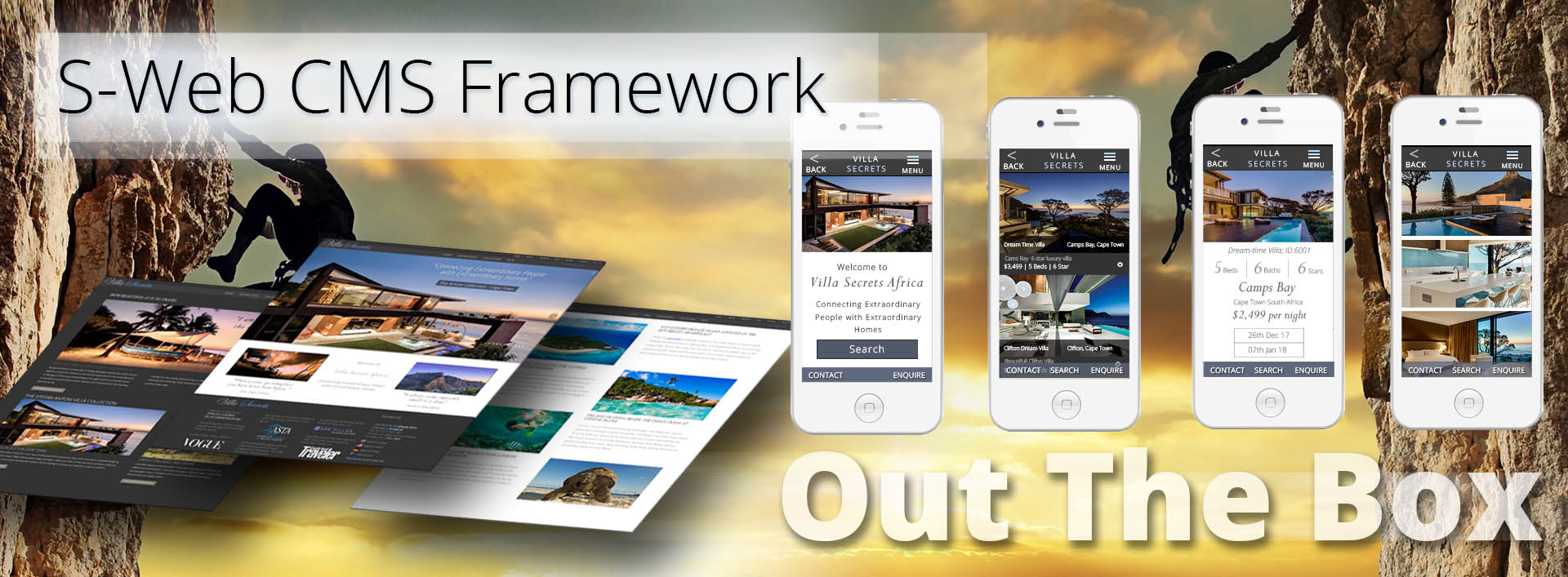
Before we begin explaining what we want to achieve, a word to say we are not there yet. The CMS is complete, so each page can be created per the previous points. And in the forthcoming section, S-Web CDS™, we show how we can already create users’ individual customised web pages for their own use at the touch of a button. But in terms of a complete out the box website, we can’t yet create one at the touch of a button.
However, what we can do is create batches of websites. We will see in Chapter 2 that we have 200 web domains ready. And between 2018 and 2020, we will create an S-Web website for each, and then present each website as an ‘out the box solution’ to various partners around the world.
However, it is our objective to be able to create a user website as simply as buying a domain name and off they go. This is not an objective that we are looking to achieve soon.
However, should Facebook or Microsoft (well actually the Chan Zuckerberg, Paul G Allen, and Gates Foundations) pay interest in our project and secure the significant amount of equity in Villa Secrets Ltd. (the holding company) that is currently reserved for them, this is one of the first things I would ask them to work with me on.
And we would not just do this for Villa Secrets, instead, we would create S-Web.org and versions of S-Web for everyday use for everyone, with the extra hook being that we would not charge for it and we would give free hosting. So, literally, the cost of creating a great website was just the cost of the domain at about 10 US dollars a year, for a product that is far simpler than any other and looks better than most.
Where we get paid is if people use their S-Web sites for business and, in which case, we would ask for a royalty.
The biggest win comes from complex sites that wished to use database inventory; such as Villa Secrets, where one can only use databases that are connected to S-Web from which a royalty will be collected, in the same way it is for Villa Secrets of between 2.5% and 5% of each trade. And in the Facebook and LinkedIn worlds of billions of users, steering those users to use S-Web for their e-commerce needs and receiving a 2.5% to 5% royalty is a very big deal indeed.
What’s to stop Facebook and Microsoft just doing this themselves?
This is the question I have heard from literally everyone I have discussed this with. For sure they have the technical skills, that’s why we’re going there ourselves. However, the reason (I hope) they would choose not to do this themselves lies in the subject of the next book in the Angel Theory series: ‘M-Systems’ (now Paradigm Shift).
M-Systems is an ecological and philanthropic super project on a scale much bigger than anyone has ever imagined. It is the macroeconomic plan to the Villa Secrets microeconomic plan, and whilst on the surface they may seem very different, they are in fact two sides of the same coin. (Indeed, now Villa Secrets and The Total Business Systems are the 4th book in the Angel Theory – Paradigm Shift Series, see www.angeltheory.org.)
To put a scale to it, consider the statistic quoted from the Sales Executive Council, who if we remember serves 200,000 businesses: “When you put it all together, only 14% of companies so called unique benefits were perceived by customers as both unique and beneficial.”
With 22 chapters of unique and beneficial systems, Villa Secrets systems can be argued to be statistically 154 times more unique and useful than the average business.
But here’s the thing, S-World Villa Secrets is only the first of 16 M-Systems, each as powerful and some more so. And as such, if we follow the math, the M-Systems design is statistically over 1000 times more unique and useful than the average business.
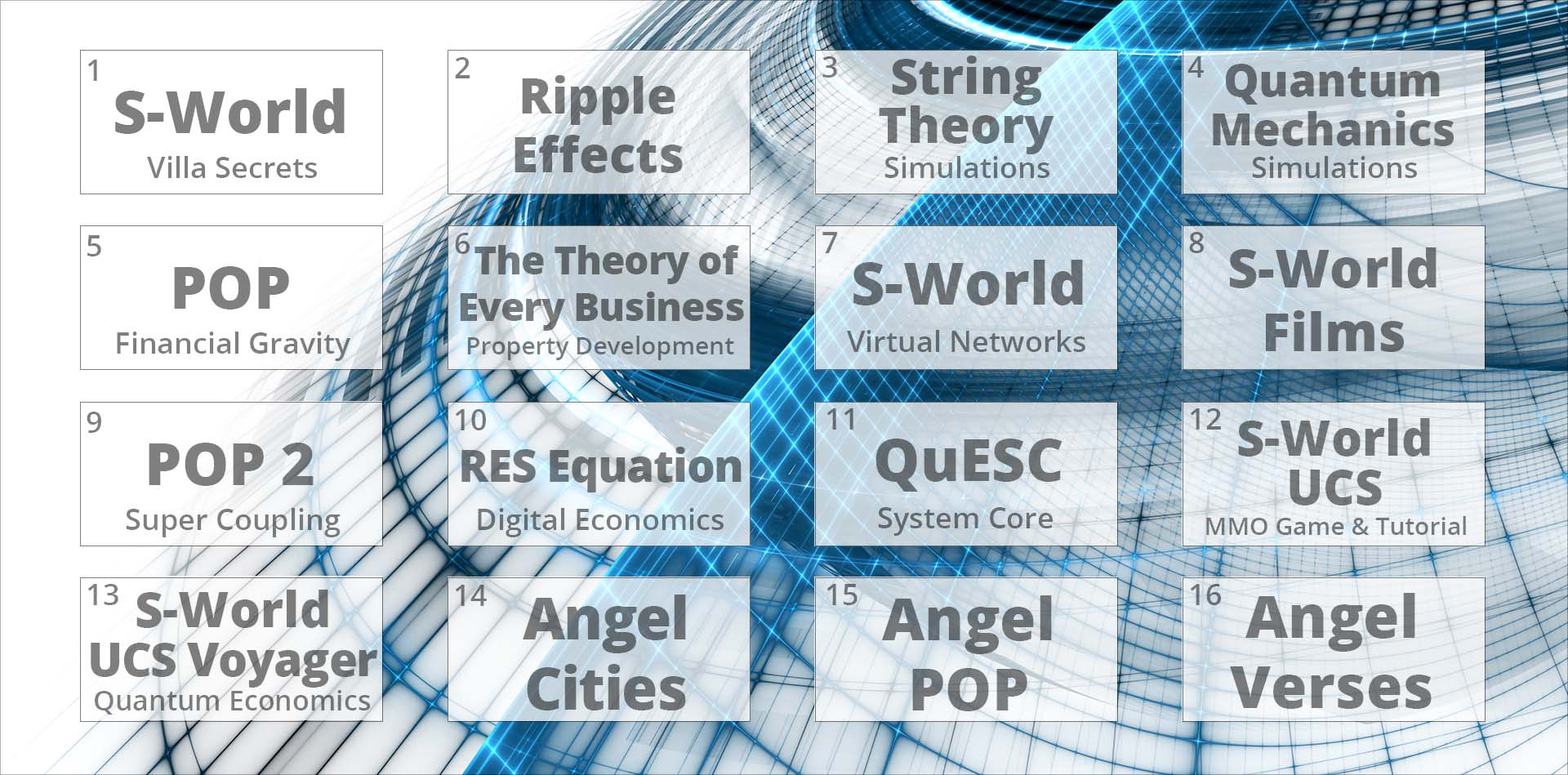
Within these systems lies that answer to why Facebook and Microsoft or others would not just ‘do it anyway,’ as their founders are not primarily interested in making money. Mark Zuckerberg (co-founder of Facebook) has pledged 99% of his fortune to improving the world and in particular ‘advancing human potential and promoting equal opportunity.’
Paul G Allen (co-founder of Microsoft) says, ‘The possible is constantly being redefined and I care deeply about helping humanity move forward.’ Allen has a passion for Ripple Effects and Elephants, which is the subject of M-System 2, an extension to our 2012 www.AmericanButterfly.org on economic butterfly effects which became the forerunner to both Villa Secrets & M-Systems.
Last but by no means least is Bill Gates (co-founder of Microsoft). We can trace the beginning of Villa Secrets, Angel Theory, and M-Systems to the Bill & Melinda Gates Foundation and in particular Bill Gates’s Harvard commencement speech in 2007, as the inspiration for what was called ‘Give Half Back.’ In which we would create a system that was more than twice as profitable as others, and so could afford to ‘Give Half Back’ without the participants being worse off for it, and indeed better off for it, due to the positive PR and branding associated with the charitable giving.
It is the Angel Theory assumption that Zuckerberg, Allen, Gates, and many others are more concerned about how they can help humanity and our planet than any other pastime. And if M-Systems can deliver on its ambitions, we sincerely hope that Zuckerberg, Allen, Gates, and others will jump on board; add to, own, and improve the system by taking their equity in with Villa Secrets and S-Web.org and becoming trustees of S-World (The Sienna Foundation).
S-Web CMS Framework Part 3
S-Web CDS, The Villas Cloud, and S-World CRM-Ai
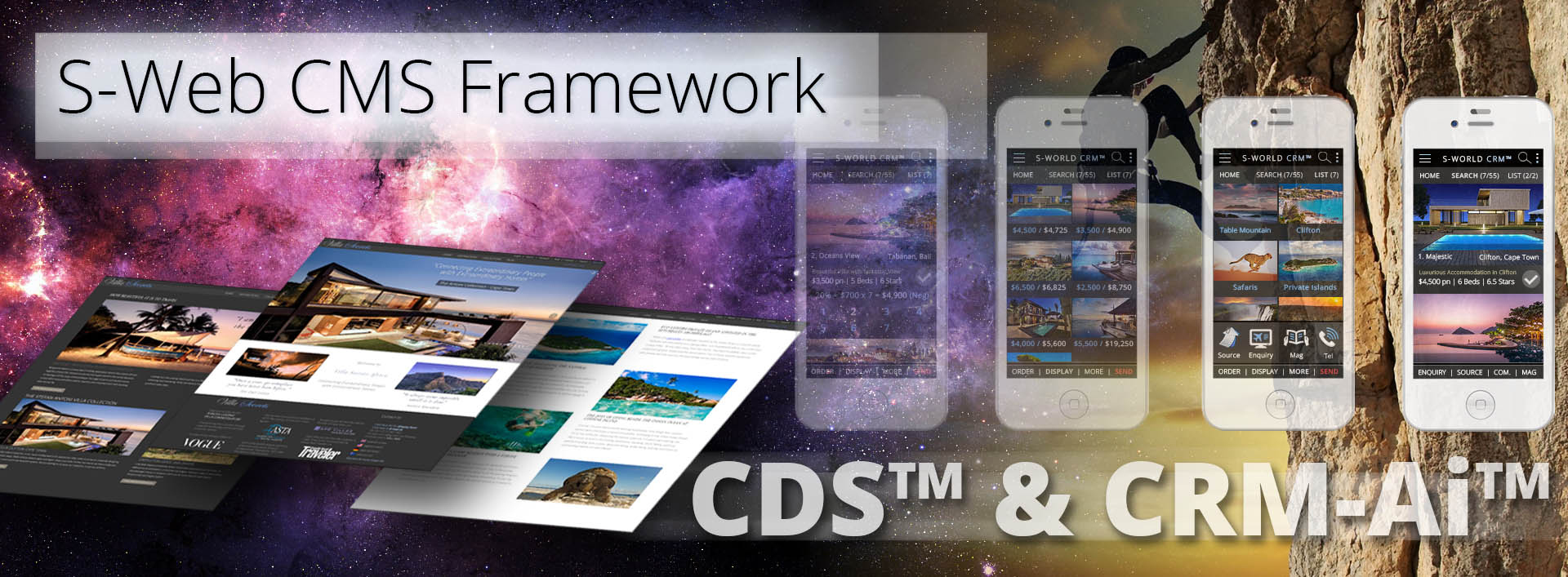
Putting aside any involvement from philanthropic or other investors, as this book is about certainty, with the investment income we receive from the first Primary Network (being $42,000 deposit moving up to $168,000 by the end of 2019), we can afford an additional 3 Senior Zend framework qualified programmers and an App specialist, creating a team of 6.
Given an October 2018 start, 3 Zend framework qualified programmers added to our current superhero programmer Vineeth and our slick designer Piyush, plus an App specialist is all we need to create all the sections presented in the conclusion of this chapter by the end of 2019. (For the latest development timetable, see (or ask for) Chapter 23.)
In this section, we find software integrated into the web framework that we are currently working on. Of which, most of S-Web CDS™ is complete, phase 1 of the Villas Cloud™ is complete, and we are very close to a working alpha version of S-World CRM Nudge Ai (sales assistant and automation).
First, we present the S-Web CDS™ which really is a truly original system that has become the backbone to many other systems. We did not set out to create this system, we were programming wild and free seeing where the wind would take us, and it pretty much created itself as we expanded upon the S-Web CMS Framework.
S-Web CMS Framework Part 3
a. S-Web CDS™ – Content Delivery System
After creating the homepage CMS, we had a problem. We wanted the Villa Secrets website to be like a magazine, not just a directory of products. I wanted most of the links on the homepage to lead to quality articles about various products or locations, not just links to products.
So, we needed to create an Articles CMS, and it was in building this that we managed to make it so well that after the 10 minutes or so it would take to create an article header, a short description and a 60-word introduction; we could create an full rich content article within a minute.
Please watch this three-minute video presentation: https://youtu.be/X9-o3E4n2Dk to see me create an online magazine article in less than a minute (once the title, description and 60-word introduction has been created).
To see the article I made in the video, follow this link: www.villasecrets.com/Magazine/6-Exclusive-use-Safari-Lodges-to-fly-for-By-Nick-Ray-Ball/6811.
One minute to create an article that, when including all the original copywriting, photography, and image editing used to take us about 3 days.
The trick to it, that turned a task that took hours into a task that takes minutes, was that instead of just making a template for a new article, we gave the user the option to call in the pictures and 60-word introductions and other details from product pages and from other article pages. And this simple action empowered the user after writing an introduction paragraph, to call in a variety of different products and articles to create a well crated image rich page, in less than a minute. Including the eye-catching picture slider at the top of the page, in responsive design looking great on mobile as well.
Hence the name ‘Content Delivery System’ (CDS), as we deliver previously made content into new pages, or newsletters, emails and even specialist web pages created specific for an individual client.
S-Web CDN ™ (Content Delivery Systems)
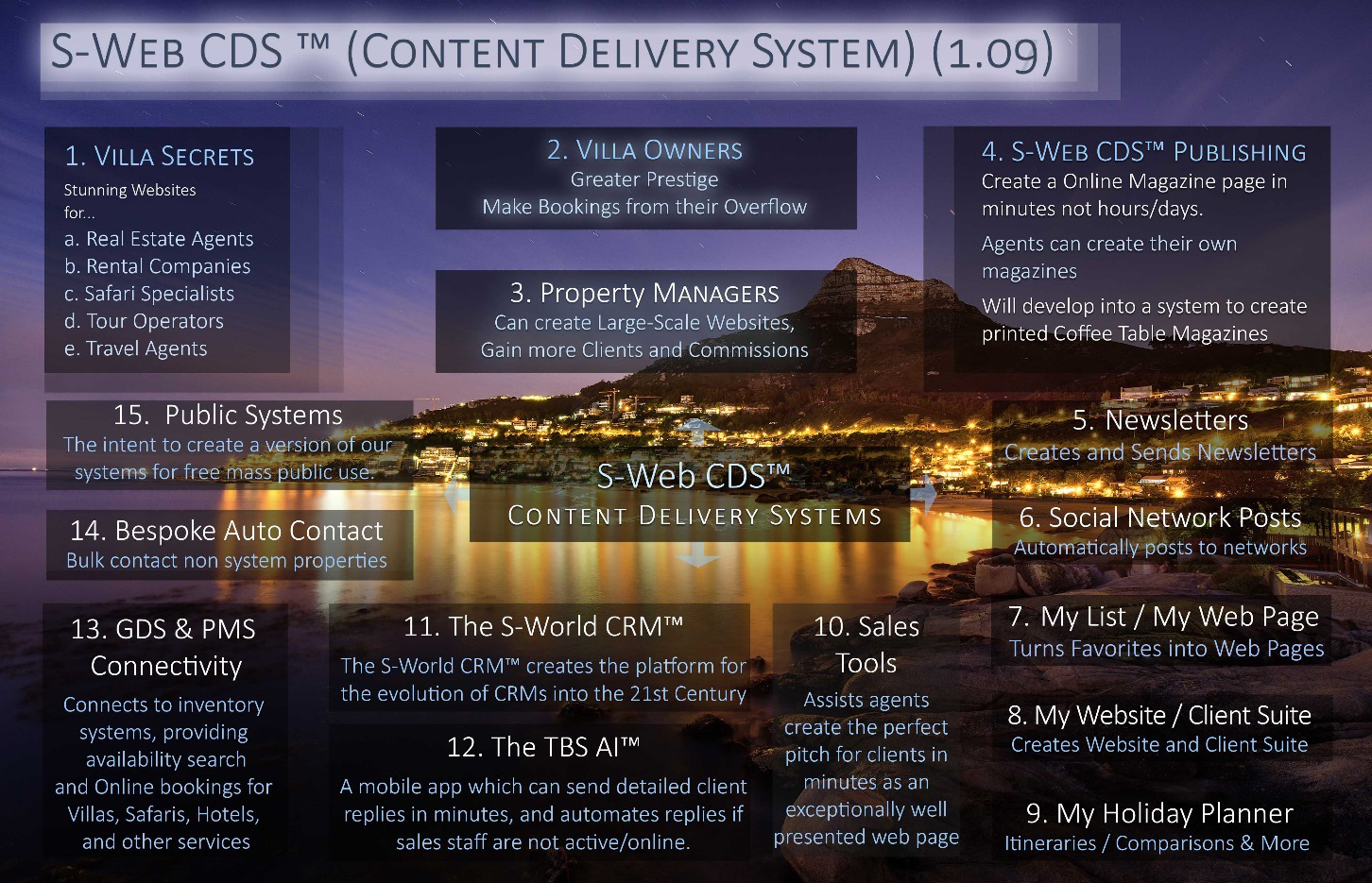
One may recognize the graphic above as a predecessor to the full 25-chapter Villa Secrets’ Secret business plan. That’s how important S-Web CDS™ is in terms of linking the S-Web framework into the core of the business, it was the magic source in creating super-fast and simple web page creation.
Once we had the framework design and could make article pages in seconds not days, it was an obvious jump to create an online magazine.
S-Web CMS Framework Part 3
b. Online Magazine, Newsletters, and Printed Media Publishing
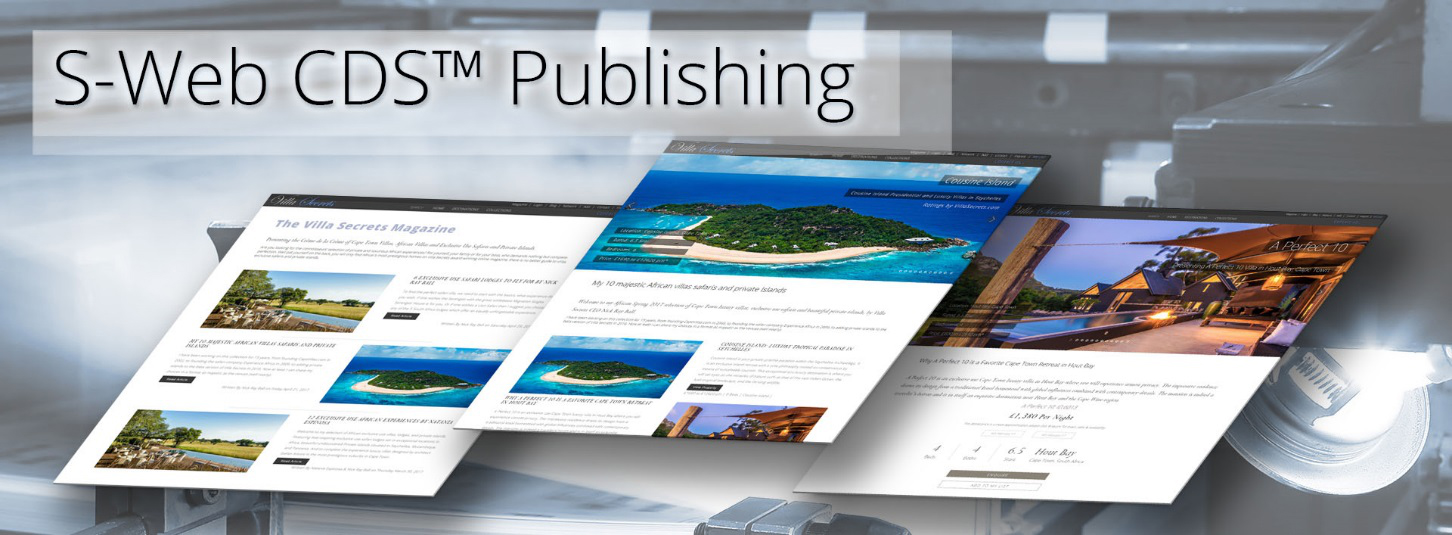
Welcome to the S-Web CDS ™ (Content Delivery System), the Villa Secrets Online Magazine, Printed Book Publisher, and Newsletters.
www.villasecrets.com/Magazine
As we can create articles in minutes, each Villa Secrets company can go blog and magazine mad, with each sales staff members having their own magazine featuring their own articles, made in no time at all. This improves the website, is the key foundation of a good content marketing strategy, is a great addition to the CRM (customer relationship software) as the sales person, and send an article a week to their previous or current clients.
Personalised magazines will give the client a far better impression of any sales person as they will seem knowledgeable, involved, and passionate about their products and insights.
Plus, it is infinitely better to ask a client if they would like to receive their sales person’s personal magazine, in terms of sustainability of the magazine newsletters, as people only have time for so many newsletters, choosing to unsubscribe to most. The fact that they will not be receiving newsletters from Villa Secrets, rather their agent that they know at Villa Secrets, will greatly decrease the chances of the newsletters being unsubscribed.
Printed Magazines and Coffee Table Books
We can see the very well-considered plans for the Villa Secrets Coffee Table Book in Chapter 18. Following on from the last magazine ‘Cape Villas’ that was distributed by Condé Nast Traveller UK, creator of our biggest booking by far, acclaimed by Bulgari who offered $100,000 in barter items to be the principle sponsor of the follow up.
For now, we shall just lay out the technology and it’s really simple. We adapt the current CDS™ and create a selection of CMS pages for different book or magazine page layouts, with the ability to move the +/- 60-word text block around each page, then convert it to a PDF, give it to the printer; and hey, presto, that’s 50% of the cost of the average print publication saved. Plus, we get to make a very well laid out online version at the same time and can make updated version of the magazine very simply.
S-Web CMS Framework Part 3
C. My List / My Webpage
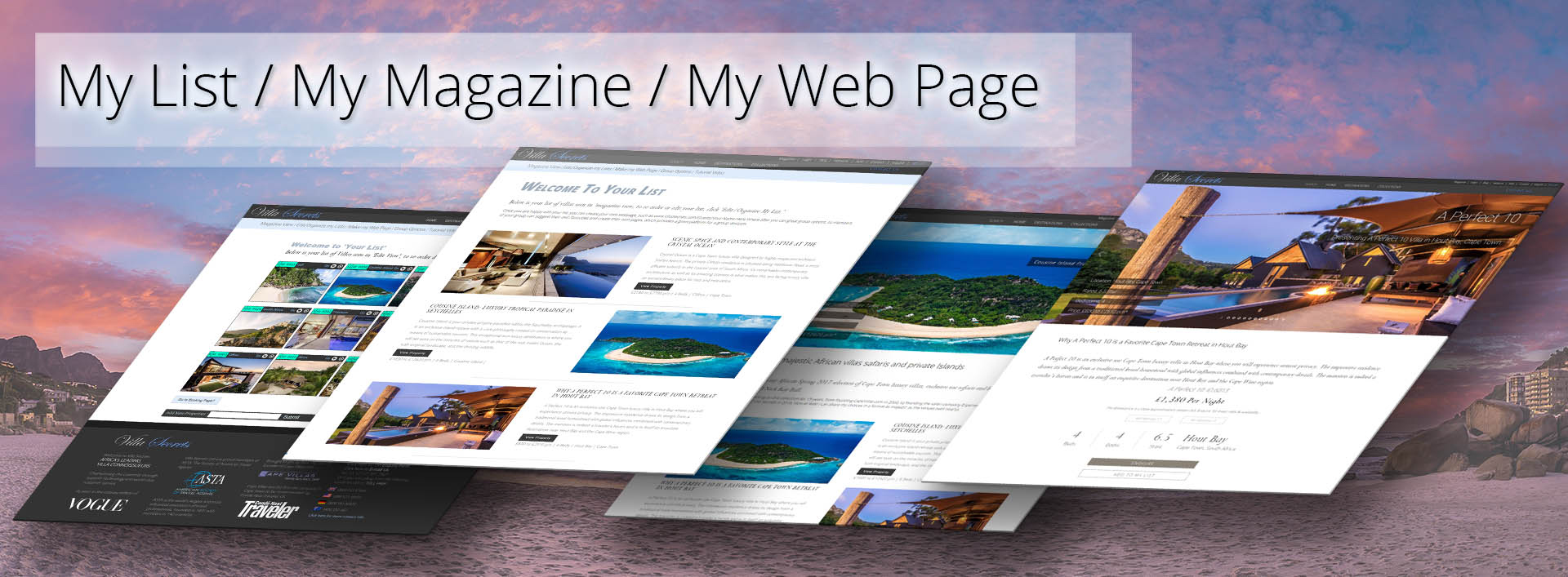
Welcome to MyList / MyMagazine / MyWebpage, in which we give clients the option to turn there ‘my favourites list’ into a magazine display and then a unique webpage.
Please watch this 2-minute video https://youtu.be/JS8vJQ1KxbM
And please try it out yourself by making your own Villa Secrets webpage.
1. Visit www.VillaSecrets.com.
2. Go to ‘Destinations’ > ‘Best of Africa.’
3. Add a handful of villas to ‘your favourites list’ by clicking the ‘add to list’ buttons.
4. Go to ‘Magazine’ and add some articles.
5. Click ‘MY LIST’ at the top right of the page.
6. From the blue navigation menu under the logo, click: ‘Make my Webpage.’
7. Add your client, boss, or partner’s name and email, then click ‘Publish my Webpage.’
8. Click ‘Add Comment’ to start a very organised conversation.
This journey is as unique as the last and built upon the same principle. But this time, we create a tool for guests to use. S-Web CDS™ MyWebpage begins with the standard ‘My Favourites’ function, www.villasecrets.com/MyList.php, and presents a good-looking page with properties that can be dragged and dropped into order.
We build upon this by giving clients the option to then see their list displayed in magazine mode, which is a superior presentation, and then the clever bit… we offer a super simple way for the client to create a unique webpage, such as www.VillaSecrets.com/NickRayBall or any name one wishes which he/she can send to their wife, husband, partner, boss, or any others in the group.
This accomplishes several objectives: It captures the clients email address and lets us know which villas he/she likes, and it increases the likelihood of a client booking as the more time they spend amending, showing the webpage to others, the less time they will spend looking for alternatives.
In addition, the list function can help the client become a motivator within their group, even if others in the group are talking to other agencies. The lists tools can win the day, as the organization of the list is far superior to any list of links via email one party in a group may send another. And as the others in the group can make their own list, this organizational tool can and will often win the day.
S-Web CMS Framework Part 3
d. The Villas Cloud™ – Online Availability & Bookings

Moving from Chapter 4 to Chapter 5, the Villas Cloud™ is currently all about live availability. In time, it will grow to include a property management system and distribution channels. However, due to politics, these functions may well be created as/ or by separate S-World companies.
Currently, we are only focusing on fetching availability data live, so our clients can search for villas that are available to book now, and our agents can simply look on our website to find properties that are available. And so, we can build upon the ‘MyList / My Webpage’ CDS™ functions and enable the Nudge-CRM-Ai™ to automatically reply to clients by email, presenting villas that are available to book.
Currently, we are connected to MyBookingPal. But across the world, there are hundreds of systems that we wish to connect to, including many smaller systems or agencies’ own inventory databases.
S-Web CMS Framework Part 3
e. S-World Nudge CRM-Ai™ – Automated tasks
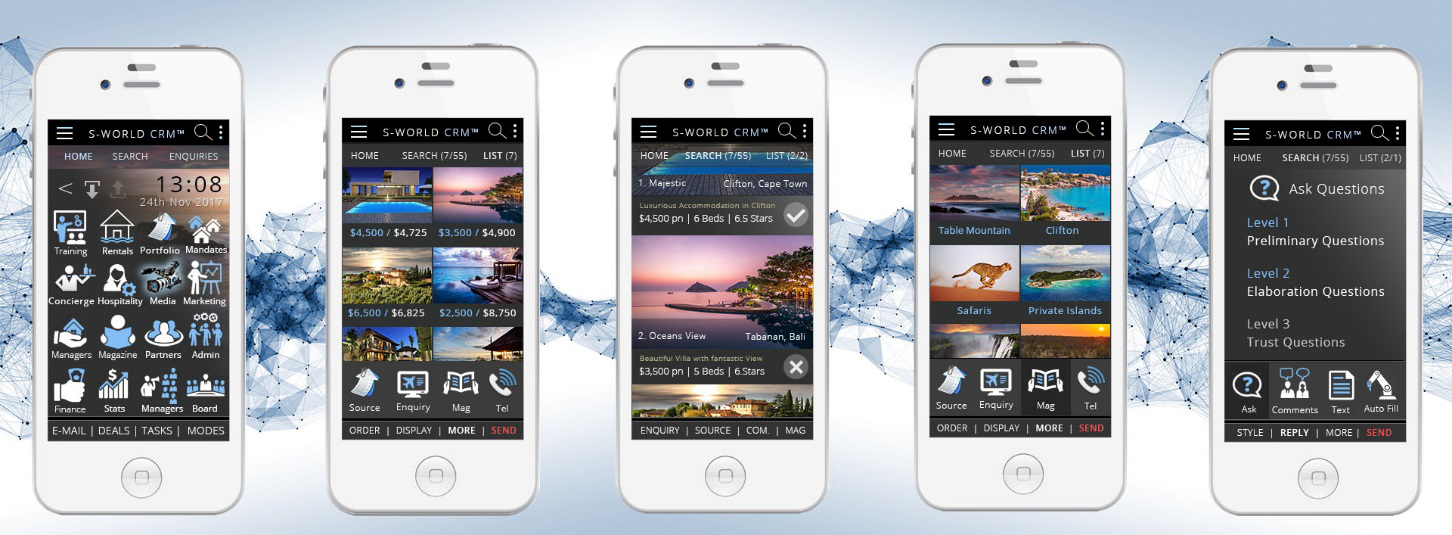
Now, we move into Chapter 6 and the CRM functions, functions that improve sales and the customer experience.
In a nutshell, the Nudge CRM-Ai™, or as it is also called ‘the Raybot,’ is designed to automate the enquiry process; by analysing the enquiry data and creating an email response of a quality far beyond any current automated system, which can be automatically sent after 5 minutes; if a local or call centre agent is not available, steering the client to their webpage/client suite, to refine the search criteria and answer important questions. Then follow up and keep the lines of communication open until an agent is available. (Note that statistics say, the chance of making a sale decreases by more than 50% if an enquiry is not answered within 5 minutes.)
Whilst it can run on autopilot, the CRM-Nudge Ai™ is designed to work with agents. So, going back to the 5-minute time point, if the agent picks up the enquiry before their reply, it is already very well organised. And if the agent is out viewing a property or it is out of office hours, they can work with the CRM-Nudge Ai™ from their cellphone, from desktop or mobile. Within just a few minutes, the agent can send a quality and well researched reply to any new or ongoing enquiry; including prompts that take heed from innovative sales methodology and psychology, such as three levels of questions from ‘The Science of Selling: Proven Strategies to Make Your Pitch, Influence Decisions, and Close the Deal’ by David Hoffeld,’ which assist the sales person to influence the client and help close the deal.
Note that since writing this book, the plan for the CRM-Nudge Ai™ is to seek assistance and, in turn, offer generous equity in Villa Secrets USA and other projects to 2017 Nobel award winner Richard Thaler, author of ‘Misbehaving: The Making of Behavioral Economics’ and ‘Nudge: Improving Decisions about Health, Wealth, and Happiness,’ as lead advisor on the CRM-Nudge Ai.
The system will automatically contact all ‘bespoke’ properties (properties that are not on booking systems), be them villas, safaris, or private islands by email. And as the property managers of such accommodations click the ‘yes, the property is available’ button on the email, the property is added to the list and sent to the client. This single point is massive as it does something no other agent would do, or at least no other agent is currently doing; and that is to contact all ‘bespoke’ properties that match the enquiry, not just the few that the agents immediately think of.
To use the system, one starts with the search results created from the enquiry, of which the Ai will have picked 3 or 4 properties to send to the client and will have added a few magazine articles at the bottom of the email. The agent has the option to change the villas, simply by scrolling down the list and clicking the tick or cross button in the search.
One particularly useful function will be the ‘see commission’ option. Below, we see that in action. First on the left, we see the initial enquiry and the 5-minute countdown. If the agent picks up this enquiry, they just need to look at the list of available villas as seen in the second phone (note this functionality as already complete) and tick or untick the properties to send. Next in phone 3, the agent has hit the ‘Com’ button and the commission and total income made from the booking is displayed. Then in phone four on the right, the agent has chosen a different view showing more villas on a page that can be reordered easily, and which display the price per night and the commission made.
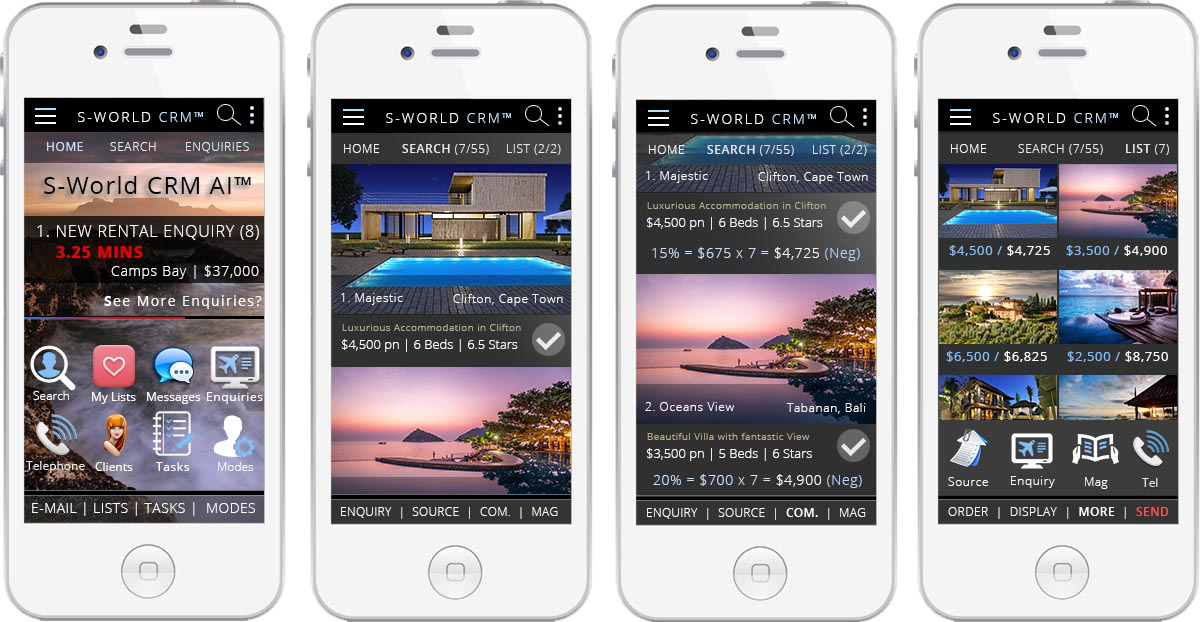
Below, we see the second half of the journey. First, the addition of 3 magazine pages. Then the email format which can be changed at the tap on a button, followed by question options, carefully created to suite not just the industry niche but also the location.
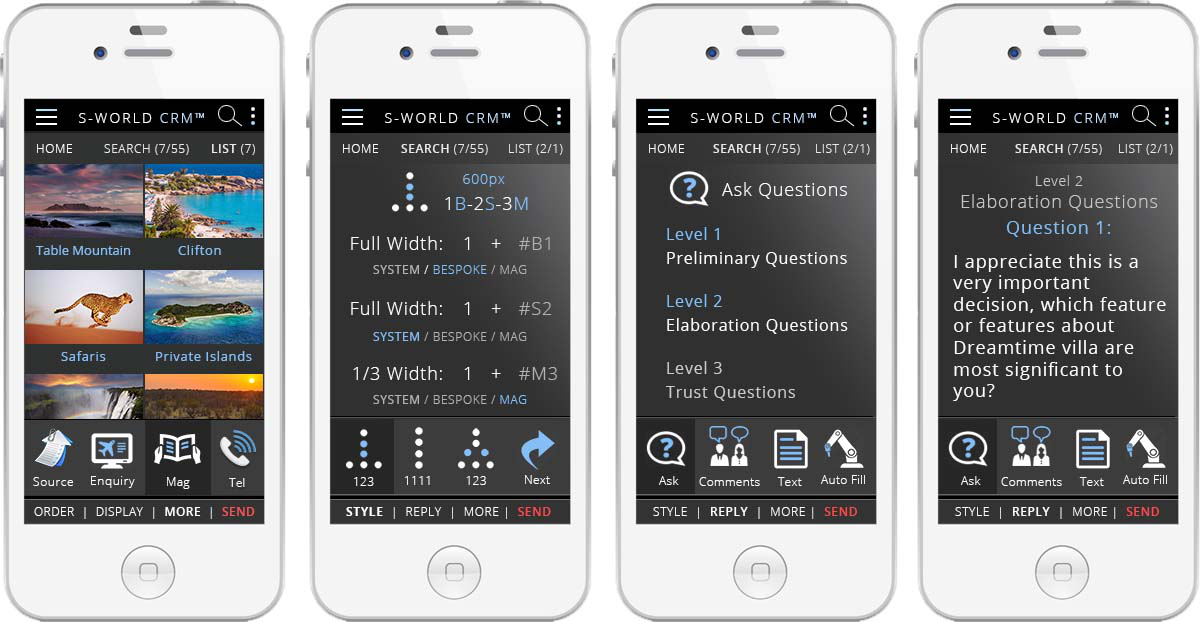
These questions will be carefully created (we hope by Thaler and colleagues) to engage the customer’s subconscious and to make them focus on why they like the properties they select or choose; and are, in fact, good service in general as they provide the sales person with insight into what the customer’s primary buying motives are; and so, the agent and the system alike can better recommend properties.
Once the questions have been chosen, the email is ready to send, which can be followed up with a phone call. A phone call that will be all the better for the agent having used the CRM-Nudge Ai™ and learned how to ask good questions and other sales techniques that the CRM-Nudge Ai™ provides, such as ‘How many properties should one send in the first place?’
However, if the agent is out of hours and the call centre is not yet in operations, we can target the ‘very important’ enquires to be sent to them, which using the CRM-Nudge Ai™ cuts the time it takes to do the search and make a well-considered reply down to just a few minutes. And as such, with only a few or maximum a dozen enquires per day being ‘very important,’ it’s not an imposition to expect top agents to be available to answer big bookings in most waking hours, which we know from experience can greatly increase conversions (bookings and sales).
When the client receives the email, it will have added an introduction, a key 2nd level question, a link to the client suite, the photos and the description for each villa (usually 3), a link to a search results page to showing many more villas, a row of magazine articles, possibly more 1st level questions, and a conclusion.
Where after, the client can either go to their client suite, which is currently their My List /My Webpage page, or they can reply by email, or pick up the phone. And if client is calling from the UK, USA, Germany or Australia, the call is free. And a ‘Call us Toll Free’ button will be added to the email and shown on line.
Development
Currently, as of the 9th July 2017, we have created about half of this in desktop format; the property display on mobile, the client suite and dedicated webpage, and the CDS™ functions, plus we have created many email templates.
We need to make a CRM login that shows the website as normal, but with additional data, such as the commission rate. Then sales people can simply use the CDS™ My List /My Webpage to finalise the property options, and we need to add a page that changes the email template and question options, then connect it to the email template. Once achieved, we have a tool for desktop that a new sales person can use to create replies to enquiries like an experienced agent, or can assist an experienced agent to work 2, 3, or even 4 times faster and do the job of many, which saves a lot. As with greater productivity, a sales agent can make more money on a 10% commission, than they would getting a 20% commission in a less efficient manner.
Once the basic, but still critically a useful version described above is made, It will take some testing to get the questions right and a slick desktop version working.
S-Web CMS Framework Part 4
a. S-World TFS™ – Total Financial System

Since 2011, the primary objective of S-World Villa Secrets in terms of systems has been to create a simple financial system as a part of the core software design.
In 2011, the first version of this business plan found at www.s-world.biz/TST/The_Virgin_Business_plan_in_Retrospect.htm combined a CRM (customer relationship management system) alongside a financial system, and a GDS (global distribution system) which provided access to online availability, as was previous presented as The Villas Cloud™.
To many, the idea of creating financial software may seem a highly specialised art, but it’s really not. At this basic level, it’s actually one of the easier projects. There is a general rule to consider in programming that if something can be created on a spreadsheet, it’s simple too within an online database. Then all one needs to do is be competent at making CMS pages, to display the data in simple fashion and, as this entire chapter is about our S-Web CMS Framework, we have this covered.
The trick to the system that is unique (as far as we know) is how we avoid human error and make fraud much harder, which is to download the banking data as a spreadsheet and upload it into the system, along with a screenshot of the banking page, which may sound a bit old school, but it works.
We are yet to create the ‘Mobile First’ design, but I am looking forward to it. Chapter 7 expands upon the TFS™ and provides ‘Emotional Impact’ sections that present a series of problems and solutions gained from 10 years’ experience of financial managers and accountants (who should have known better) getting it wrong time and time again; and how the TFS™ has learned from this and makes a simple platform for Villa Secrets companies to avoid such problems, allowing them to focus on their strengths and reaching their and the companies’ potential.
S-Web CMS Framework Part 4
b. S-World CRM CC™ – Company Controller
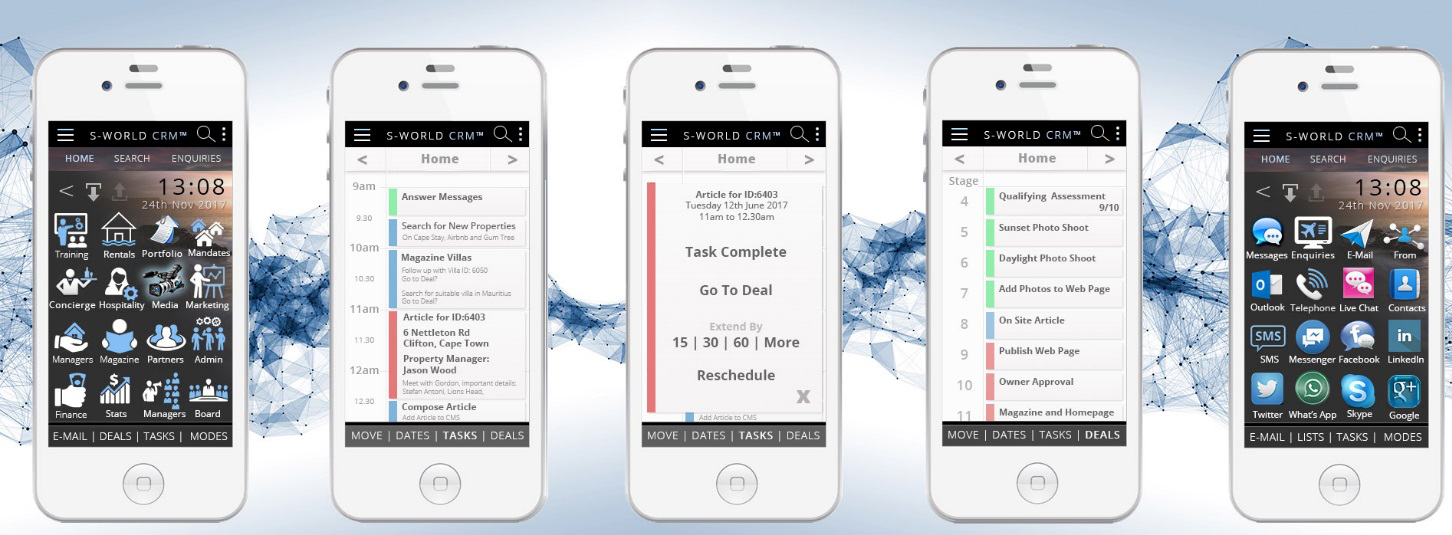
Welcome to the S-World CRM-CC ‘Company Controller.’ Taking control of each Villa Secrets partner company.
We have seen how the S-World CRM-Nudge Ai™ allows a good sales person without experience in the industry to take control of the booking process in all waking hours, effectively doing the job of a small sales team on their own with greater efficiency. Now, we look at monitoring and incentivising the entire team, from the intern to the CEO.
Whilst this was originally created to manage staff production and performance and a way to avoid the need for an operations manager or MD, since creating the plan and chapter, an even greater motivation for the use of this system has be unveiled within ‘The Science of Selling: Proven Strategies to Make Your Pitch, Influence Decisions, and Close the Deal’ by David Hoffeld.
Hoffeld describes how an experiment in staff motivation yielded surprising results. In the experiment, 50% of staff were given additional work-based benefits. But after the experiment, when the data was examined, productivity of all staff improved. This went back and forwards with different motivations and even a group that had their benefits removed. But no matter what, performance just got better and better, even for those who had lost their benefits.
So, what in going on?
The incentives that motivates and encourage staff were not as powerful as the simple act of observation, they call it ‘The Hawthorne Effect’ (also referred to as the observer effect), in which individuals modify an aspect of their behaviour in response to their awareness of being observed.
And so, the CRM-Nudge CC™ is doubly useful, it not only monitors and tells staff which tasks to do, it increases their performance by giving the impression that staff are constantly being observed.
Like the CRM-Nudge AI™, we are developing this system ‘Mobile First.’
Below, we see the design for the CRM-Nudge CC™ (Company Controller). The second icon you see, ‘Rentals,’ would lead you to the CRM-Nudge Ai™. The rest of the icons lead to different user types or functions including: Training, Villa Rentals, Portfolio Management, Mandate and Best STO acquisition, Concierge, Hospitality, Media Production, Marketing Objectives, Property Managers, Magazine Creation, Partner Deals, Admin, Financial, Stats and Sales Funnels, Managers, & the Board of Directors.

In the initial version, we are only including functions we can create quickly. All we require right now is a calendar & planner, deal steps, targets and incentives; all wrapped up within a game of sorts that gives points per completion of task, booking or sale.
Day Planner and Alerts
One of the big tricks to create, the calendaring, is in a way that it has ‘important tasks’ and ‘tasks that are useful but not essential.’ So, if a task takes longer or is delayed, the entire timeline can be shifted back, keeping the important date sensitive tasks, and tasks that require collaboration in their original dates. To accomplish this, we start by spreading out the essential tasks, with plenty of time in-between each, which is filled with useful tasks, such as prospecting for new villas and mandates. And if there is a delay, all the nonessential tasks get moved back, whilst the essential and time sensitive tasks stay in place.
Below left, we see the day planner in task mode, which assigns different colours to different tasks based on importance. Green is for an important regular task that should not be missed. In blue, we see tasks assigned that can be put back if a more pressing task arises or if a previous important task has overrun. Then in red, we have tasks that are very important, usually involving a meeting, collaboration, or a deadline.
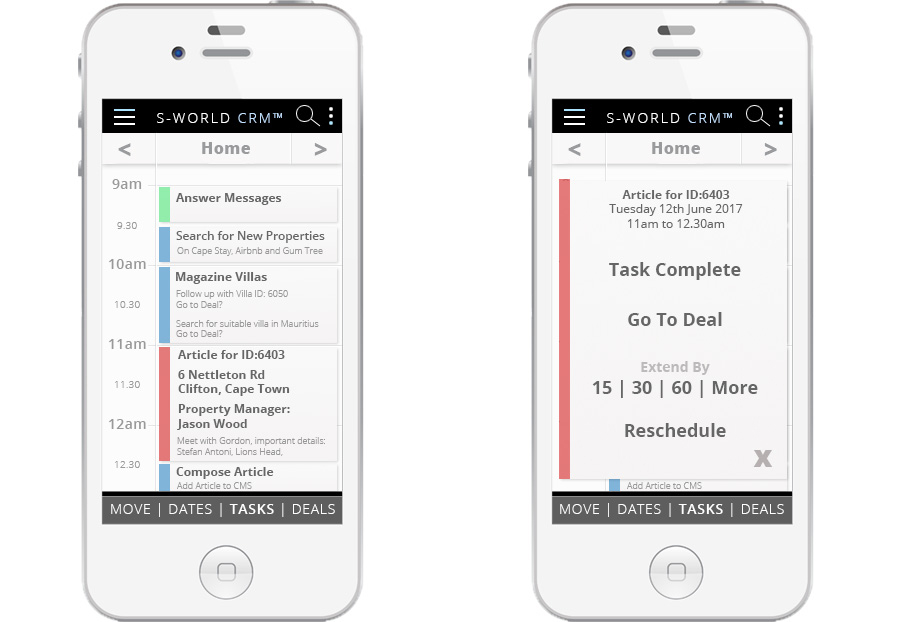
In this scenario, the staff member with the dual role of copywriter and portfolio manager has a meeting with a property manager at a villa at 11am to 12.30 in the afternoon.
Above right, we see the alert that beeps and pops up at the end of the task time, from which the user can click ‘Task Complete’ (which will update the corresponding deal), or click ‘Go to Deal,’ ‘Extend Time,’ or ‘Reschedule.’
Sole Mandate & Best STO Deal Preparation
STO stands for ‘Standard Tour Operator Discount’ and is the difference between the ‘public rate’ charged by the property and the discounted rate offered to the agency.
In the graphic below, we see the ‘deals’ page, which will have automatically updated as soon as the copywriter / portfolio manager has clicked ‘task complete’ on the previous graphic, moving deal stage 8 from Red ‘not complete’ to ‘green complete’ (as the deal stage is currently in progress, it is in blue).
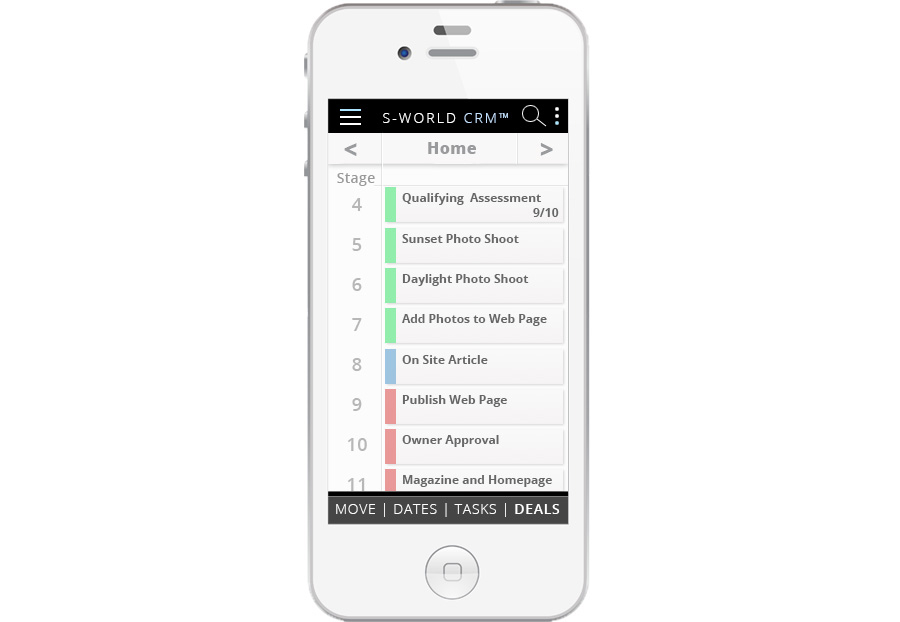
There are 11 different stages to this process that happen before we pitch for a mandate:
1. New property identified
2. Basic details received
3. Got images
4. Qualifying assessment 1 to 10, where we prioritise higher numbered properties
5. Sunset photo shoot
6. Daytime Photoshoot
7. Add photos to webpage
8. On site article
9. Publish web page
10. Owner edits/ approval
11. Magazine article & home page
(And note now with S-World Film and The Famous Concierge adding quality videos to this list.)
This last deal stage is where magic can happen. Not only does the villa webpage look this awesome (www.villasecrets.com/Villa/North-Island-Villa=6061) but in just a few minutes, we can create an online magazine article, presenting it as the featured villa in an illustrious company within a pan African mega villa article, which also temporarily adds the property to the home page.
When the web page, mega article, and home page are presented; this is the point where managers and owners see Villa Secrets as the company that goes the extra mile. And that is the time to start the pitch for a mandate, as an experienced and seasoned sales mandate specialist joins the portfolio manager to help bring home the opportunity, following a different deal path specific to the task.
Even if a mandate is not secured, one will have made better friends with the manager and owner and may get a better STO or better bespoke discounts for quality bookings, and we have more great content for our clients to look at and other websites to link to.
S-Web CMS Framework Part 4
c. S-World UCS™ – Competitive Games, Fun, and Addictiveness

Following on from the conclusion of the reframe in step 2, S-World UCS™ is a massive system initially considered in 2003 as a management game called ‘Villa Mogul,’ in which players could run their own version of Cape Villas.com and expand upon it to forge a global real estate empire.
The difference between this and other management games (at the time) was in part our unique virtual tours providing better graphics; but mostly, as it would be the first game based on a real business, it would have significant PR benefits for the parent villas company; and networking benefits as gamers could win the rights to open their own international franchises. Well, that was the 2003 thinking, which is now upgraded into the S-World Network and Angel Theory – Volume 1. Paradigm Shift.
In 2011, the first of the 11-point travel plan we created with Facebook in mind www.s-world.biz/FaceBook/1_The_FaceBook_Travel_Tutorial_Game.htm taught users to appreciate and learn both the industry and our systems, before trying the business for real.
Then, in 2012, in the final chapter of the first American Butterfly book: ‘The Theory of Every Business,’ expanded upon the theme with the more inspirationally titled ‘Universal Colonisation Simulator’ or S-World UCS http://americanbutterfly.org/pt1/the-theory-of-every-business/ch8-s-world-universal-colonization-simulator.
More recently, in Angel Theory – Volume 1. Paradigm Shift S-World UCS™, is the tutorial, recruiting and simulations software at the heart of the system, being the subject of Books 2. Part 2. A More Creative Capitalism, Book 3. The GDP Game, and Book 7. S-World UCS.
In the Villa Secrets UCS plan, we have allocated significant funding for profit share which gets distributed to those who have accrued the most UCS points.
It’s a simple enough system to program, each task completed, each best STO or mandate secured, and each booking has a points value. And as staff and management complete their tasks, they win points. And each day, there is a points winner, and the points winner gets a percentage of profit share.
Created in this way, we can allow for a sales agent to bring in a big booking, or a property networker to land a mandate and receive a huge score on that day. But the next day, everyone starts from scratch. So, on any given day, anyone can win. And that’s important to the game play and will encourage staff to perform simple tasks such as increasing Facebook likes, or writing tweets in their spare time, as each action has small points score.
It also allows management to steer the team in the direction of gaining mandates and adding properties. As whoever adds a property, will see point wins every time that property is seen on the website, and more points if its booked; and more still if its booked and it makes a lot of money.
This not only focuses staff on adding properties, but also on adding properties that will make money and adding them as well as can be done; as in doing so, they increase the chances of being seen and booked, and so more points, prizes & profit share. (Prizes potentially coming in the form of handbags, glasses, perfume, and after shave from brands like Bulgari; in exchange for adverting space in the Villa Secrets Coffee Table Books from Chapter 18.)
This competition is more about motivating the support staff and management than the frontline sales and mandate staff, as such staff are already motivated with commission and in many cases, will be shareholders in the company itself.
There will be a great looking winners page that shows all points won each day and the daily top 3. And from that point, we can create weekly competitions, in both days won and total points, and monthly; and 3 monthly competitors, which will pay our significant bonuses, for winners.
This is what turns the S-Web CMS Framework from simple and beautiful to simple, beautiful, fun, and addictive. And as a bonus, as well as the motivation of being a daily or weekly winner, is that we create a very observed view point on each staff member on each day. And so, ‘The Hawthorne Effect’ kicks in improving overall performance from all team members. It also makes a bridge to Angel Theory’s’ M-system 12, but we need not get into this here.
Development Timetable
Initially, within 3 months of a request to move on this system, we can create a basic version of both the CRM-CC™ and UCS™ that will let all staff know their tasks, and we can test the point scoring variables. After this basic version, we are looking at 6 months for the alpha version, with the beta version ready another 6 months after that.
S-Web CMS Framework Part 5
a. S-World TBS™ – Total Business Systems
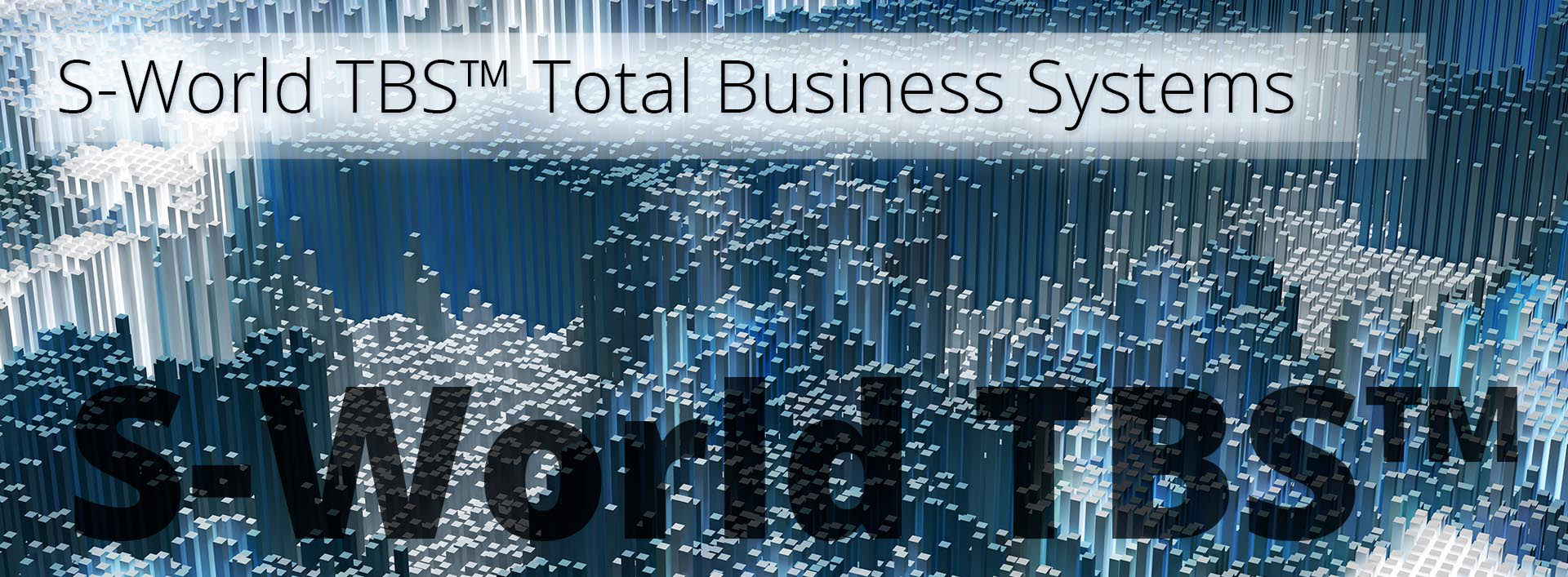
The TBS (Total Business Systems) is the collection of all web and software systems under one roof. In this chapter, we provide benchmarking data, ROI calculators, and an estimated improvement percentage that each component provides.
For some history, follow these links:
S-World.biz (2011)
The Divergent CRM (2015)
Part 1 the Total Marketing Systems (2016)
Part 2 the Total Financial and Business Systems (2016)
Paradigm Shift Book 4. The TBS™ Total Business Systems (2018)
Collectively, the combination of all software found within the S-Web framework is disruptive, but what is a disruptive system?
From our vantage point, a disruptive system is a system that has taken longer to create; but when it enters the market, it disturbs it, taking a larger market share than traditional companies in the marketplace.
In 2002, our prototype website www.CapeVillas.com with its virtual tours disrupted the Cape Town vacation rentals market, as a couple of web designers created a company that would lead the market for 8 years.
However, Cape Villas has nowhere near the disruptive firepower and potential that Villa Secrets enjoys.
In this summary chapter of the TBS™, we start with potential negative factors before zooming into the effects created by the different systems. And note that when it comes to negative factors, for caution, we overestimate. And when it comes to positive factors, we underestimate.
Below, on the far right, we see percentages estimated for phase 1 (2019). And on the left, are the full potential of each system when fully complete and tested, which could be many years away. In forecasting, we only use the lower far right figures.
| Competitors and Other Negatives | |||
| First Year Jitters |
-40.0% |
-40.0% |
|
| Airbnb |
-60.0% |
-36.0% |
|
| HomeAway |
-25.0% |
-12.5% |
|
| Other |
-50.0% |
-12.5% |
|
| Competitor Improvement |
-50.0% |
-12.5% |
|
| Total Negative |
-225.0% |
-113.5% |
Now, for the positives and note some of the systems below are not software generated but are instead staff functions, from photography to guest blogging to manning call centres.
| Portfolio Manager & Team | |||
| Adding Properties for Agents to Rent |
50.0% |
15.0% |
|
| Subtotal |
50.0% |
15.0% |
| Concierge, PR, Film, & Social Media | |||
| Repeat Clients |
25.0% |
2.5% |
|
| Referrals |
10.0% |
2.0% |
|
| Attracted to come because of Concierge |
15.0% |
3.0% |
|
| Systems created to increase the above |
25.0% |
0.0% |
|
| PR |
25.0% |
2.5% |
|
| Videos of Villas Marketed |
25.0% |
0.0% |
|
| Films of Villas Syndicated |
25.0% |
0.0% |
|
| Concierge – Social Networking – Manual |
15.0% |
1.5% |
|
| Concierge – Social Networking – Automatic |
15.0% |
0.0% |
|
| Subtotal |
180.0% |
11.5% |
| Villa Secrets Call Centre & Content Marketing | |||
| 24/7 365 Call Centre and Sales Team |
40.0% |
13.2% |
|
| Foreign language Sales Teams |
35.0% |
11.6% |
|
| 24/7 Live Chat (USA, Asia Time Zones – Multilingual) |
25.0% |
8.3% |
|
| Content Writing 1 |
20.0% |
3.0% |
|
| Subtotal |
120.0% |
36.1% |
| S-Web Villa Secrets Web Framework | |||
| Superior Visual Experience |
15.0% |
11.3% |
|
| Greatly Superior Mobile Experience |
20.0% |
10.0% |
|
| Advertise on Mobile Platforms |
10.0% |
7.5% |
|
| Subtotal |
45.0% |
28.8% |
| S-Web CDS™ (Content Delivery System) | |||
| Clients’ Lists |
2.5% |
2.5% |
|
| Clients’ Web Pages |
5.0% |
5.0% |
|
| Online Magazine |
5.0% |
5.0% |
|
| Online Magazine posts to homepage |
1.0% |
1.0% |
|
| Newsletters |
0.0% |
0.0% |
|
| Agents’ Own Newsletters |
7.5% |
7.5% |
|
| Agents’ Own – Online Magazines |
5.0% |
5.0% |
|
| Agents’ Social Networking (SN) – Manual |
15.0% |
2.3% |
|
| Agents’ Social Networking (SN) – Automatic |
15.0% |
0.0% |
|
| Rest of staff – Magazine + SN – Manual |
5.0% |
0.8% |
|
| Rest of staff – Magazine + SN – Manual – Automatic |
5.0% |
0.0% |
|
| Client’s CMS |
15.0% |
0.0% |
|
| Agents’ Desktop Quick Quality Emails |
10.0% |
10.0% |
|
| Bulk Email Bespoke Villas |
10.0% |
10.0% |
|
| Upsell Villas, Safaris, and Private Islands Pt.1 |
10.0% |
2.5% |
|
| Subtotal |
111.0% |
51.6% |
| S-World CRM-Ai™ (Bookings Robot) | |||
| Ai – Automated Replies at 5, 15 and 30 mins |
10.0% |
10.0% |
|
| Ai – Automatic Replies from Bespoke Villas |
10.0% |
10.0% |
|
| Agent – Better Organization for Ongoing Enquiries |
10.0% |
10.0% |
|
| Agent – Out of Office Replies |
15.0% |
15.0% |
|
| Agent – Saves Money on commission |
|
|
|
| Both – Upsell Villas, Safaris, and Private Islands Pt.2 |
25.0% |
3.1% |
|
| Both – Upsell All Travel |
40.0% |
0.0% |
|
| Subtotal |
110.0% |
48.1% |
| S-World TFS™ (Total Financial System) | |||
| Financial System – Data Entry |
0.5% |
0.3% |
|
| Financial System – Data Sorting |
0.5% |
0.3% |
|
| Financial System – Data Reporting |
5.0% |
0.5% |
|
| Financial System – Sales Funnel |
25.0% |
2.5% |
|
| Financial System – Auditing & Tax |
2.5% |
0.3% |
|
| Subtotal |
33.5% |
3.9% |
| S-World Villas Cloud™ (Availability) | |||
| MyBookingPal (Razor) – Availability Search |
10.0% |
10.0% |
|
| MyBookingPal (Razor) – Online Bookings |
5.0% |
5.0% |
|
| Nitro – Availability Search |
10.0% |
10.0% |
|
| NightsBridge – Availability Search |
5.0% |
5.0% |
|
| NightsBridge – Online Bookings |
5.0% |
5.0% |
|
| NightsBridge – Africa Upselling |
5.0% |
5.0% |
|
| Subtotal |
40.0% |
40.0% |
| S-Web CRM-CC™ (Company Controller) | |||
| Increases mandates |
|
|
|
| Lowers staff costs |
|
|
|
| Increases productivity |
10.0% |
10.0% |
|
| Hospitality Systems |
10.0% |
1.0% |
|
| Greater Collaboration |
10.0% |
10.0% |
|
| Subtotal |
30.0% |
21.0% |
| Total (Complete or in progress Systems) |
719.5% |
255.6% |
|
|
|
|
||
| Minus Negative |
-225.0% |
-113.5% |
|
| Total so far |
494.5% |
142.1% |
When we add it up, in terms of all the systems we have covered so far, we see that even after a very overexaggerated threats assessment for phase 1 (2019), we are winning by 142%.
And now, for the original 2016 TBS™ in 2 sections, of which you will note that many of the systems have since been removed and placed into the S-Web Framework products we have presented.

| The TMS™ (Total Marketing System) | |||
| Bing PPC (Advertising) |
5.0% |
5.0% |
|
| AdRoll & Other Remarketing (Advertising) |
5.0% |
5.0% |
|
| Content Writing 1 (Now in Call Centre) |
|
|
|
| Photography (SEO + Social Networks + Experience) |
15.0% |
2.3% |
|
| Marketing & Advertising the Online Mags & Blogs |
10.0% |
2.5% |
|
| Syndication to Blogs and Mags (Guest Blogging) |
5.0% |
1.7% |
|
| Update to Social Networks (Now in CDS™) |
|
|
|
| Social Network Systems & Staff (For Main Sites) |
15.0% |
1.5% |
|
| Newsletters (Now in CDS™) |
|
|
|
| Guest Gifts (From Magazine Barter) |
15.0% |
3.8% |
|
| Villa, Safari, & Island Brochures |
15.0% |
0.0% |
|
| Villa Secrets Magazine 1 (2018) (Run of 5,000) |
10.0% |
10.0% |
|
| Villa Secrets Magazine 2 (2019) (Run of 50,000) |
30.0% |
0.0% |
|
| Villa Secrets Magazine 3 (2020) (Run of 250,000) |
50.0% |
0.0% |
|
| Villa Secrets Films & TV Shows (Now in Concierge) |
|
|
|
| Villa Secrets Brand |
10.0% |
0.5% |
|
| Trade Memberships (ASTA etc.) |
5.0% |
1.3% |
|
| 24/7 365 Call Centre and Sales Team (Now in Call Centre) |
|
|
|
| Foreign language Sales Teams (Now in Call Centre) |
|
|
|
| 24/7 Live Chat (Now in Call Centre) |
|
|
|
| Mobile Sites (Now in S-Web Framework™) |
|
|
|
| Mobile Apps (For the Public) |
25.0% |
0.0% |
|
| Local SEO |
10.0% |
5.0% |
|
| Tutorials & Operations Manual |
10.0% |
2.5% |
|
| Awards Software |
10.0% |
0.0% |
|
| Subtotal |
245.0% |
41.1% |
| The TFBS™ (Total Financial Business System) | |||
| Financial System – Data Entry (Now in TFS™) |
|
|
|
| Financial System – Data Sorting (Now in TFS™) |
|
|
|
| Financial System – Data Reporting (Now in TFS™) |
|
|
|
| Financial System – Sales Funnel (Now in TFS™) |
|
|
|
| Financial System – Auditing & Tax (Now in TFS™) |
|
|
|
| CRM – Advanced and Other Features |
10.0% |
2.5% |
|
| Enquiry System (Now in CDS™) |
|
|
|
| Client’s CMS (Now in CDS™) |
|
|
|
| Sienna-Bot Ai (Now in CRM-Ai™) |
|
|
|
| Hospitality Systems (Now in CRM-CC™) |
|
|
|
| Experience Africa (Association Branding) |
15.0% |
1.9% |
|
| Experience Africa (Systems Developed for) |
15.0% |
1.9% |
|
| Experience Africa (Improved STOs) |
15.0% |
1.9% |
|
| PMS & GDS Connections (Now in Villas Cloud™) |
|
|
|
| Villas Cloud Booking System (Now in Villas Cloud™) |
|
|
|
| Distribution Channels (Now in Mandates) |
|
|
|
| Property Manager CMS |
2.5% |
0.6% |
|
| Owner’s ‘For Sale’ CMS |
2.5% |
0.6% |
|
| Property Owner/Manager Websites |
10.0% |
2.5% |
|
| Magic Menus |
5.0% |
1.3% |
|
| Magic Galleries |
2.5% |
0.0% |
|
| Projects (Now in CRM-CC™) |
|
|
|
| Analytics |
5.0% |
1.3% |
|
| Subtotal |
82.5% |
14.5% |
M-Systems
M-Systems are the advanced software design and networking plans. However, as these systems need assistance from Silicon Valley, we have only included some small effects created by the creation of the network in both Cape Town and Africa.
https://www.villasecrets.com/Best-Of-Africa
| M-Systems | |||
| M-Systems 2. Cape Town Network |
30.0% |
3.8% |
|
| M-Systems 2. Africa Network |
20.0% |
5.0% |
|
| M-Systems 2 & 16. Global Network |
10.0% |
0.5% |
|
| M-Systems 5. POP |
25.0% |
0.0% |
|
| M-Systems 6. S-World Resort Developments |
25.0% |
0.0% |
|
| M-Systems 7. S-World Virtual Networks |
25.0% |
0.0% |
|
| M-Systems 14. Philanthropic Projects |
25.0% |
0.0% |
|
| Subtotal |
160% |
9.3% |

Finally, we come to the total of all the systems that are complete or in progress, plus all the TBS™ & M-Systems™, minus competitors and other negative probabilities, and we equal a positive 206%.
| Total (Complete or in progress Systems) |
719.5% |
255.6% |
|
| Other TBS™ & M-Systems |
488% |
64.5% |
|
| Competitors and Other Negatives |
-225.0% |
-113.5% |
|
|
Total |
982.5% |
206.6% |
(Note: the figures above are from Scenario 7.12c, future updates will differ)
This 206% figure is relative to the ROI one should expect from advertising an average to good website; with the bare minimum of staff, without any systems, and with no repeat business. So, for instance, if a company was to make $100,000 in a year from $33,000 in advertising; the complete web framework, integrated software, and staffing as presented change the $100,000 ROI into $306,000 ROI.
Whilst this may seem like a huge gain, it is a gain that started from nothing. If instead we were to consider one of Africa’s travel success stories, such as the award-winning Rhino Africa who have invested millions of dollars in their own system development and are very well staffed; we would basically be expecting to match their performance. This 206% is no miracle, it’s standard for many big spending companies. It just looks big as we started from a low bar, the bar most new small business would start at.
The simplest way to look at it is in terms of increasing performance in two areas.
1. Increase the number of enquiries made by visitors to our web sites.
(In this case, from Google AdWords, but the same applies to all visitors.)
2. Increase the amount of bookings generated from enquires.
1. Increase the number of enquiries made by Google AdWords visitors.
In 2015, the second Villa Secrets prototype www.cape-town-luxury-villas.com (CTLV) had 5,541 visitors (clicks) from Google AdWords at a cost of $12,107 and at an average cost of $2.19. This lead to only 241 individual enquiries online, which we roughly increase to 350 to include enquiries made by email or by telephone. As such, about one in 35 Google AdWords visitors enquired.
If the much-improved website and CMS Framework, plus all systems both human and automatic can get this conversion rate down to 1 in 17, that is a 100% gain. Or better still, if we can encourage 1 in 11 visitors to enquire (which is far from an unreasonable target), that’s a 206% gain.
2. Increase the amount of booking generated from the Google AdWords enquires.
This is a harder one to work out, as we have Google SEO and other enquiry sources all thrown into the Google Analytics mix, and we did not receive Nov or Dec CTLV figures. However, estimating CTLV made about 80 bookings from 350 enquiries, that’s a closing ratio of 23%, just under one in 4.
If the much-improved website, S-Web CMS Framework, software and systems (both human and automatic) could collectively get this closing ratio up to 46% (just under one in two), then that would double return on investment again.
If we were to increase enquires from 1 in 35 to 1 in 11, and increase the bookings ratio to one in two, that would create a 414% gain, as the 206% gain is doubled.
And that’s where we go in phase 2 in 2020, as we build upon the 206% target and reach for a plus 400% increase in income made from advertising, compared to the no systems 2015 CTLV prototype.
Villa Secrets and The Chan Zuckerberg Philosophy
Now, that we have seen how by creating software within a web framework, including a plethora of unique and beneficial systems, we can give new small (Villa Secrets) companies the systems advantages only a big company enjoy; which was the pre-2011 objective, and one of the key ideas that led to the beginning of this project in the first place.
Based on the principle ‘if all systems are even,’ then a network of small companies with an owner to staff ratio of 2 or 4 staff per stakeholder, compared to thousands of staff per owner big companies have; this single factor would lead to the small owner run companies greatly outperform the companies with low ownership vs staff ratios. For the exact same reason, communism did not work. People will push their own efforts to the max if they will benefit from it. But take that benefit away, and many people will do as little as they can get away with.
Maybe the above is a bit extreme. The point is people care more about things they own, but small companies are perilous. Take away that peril and add the systems’ advantages, and a network of small owner-led companies will outperform their big company rivals. And as a by-product, this network model is the most potent way to create an environment that encourages potential, so falling in line with the main Chan Zuckerberg philosophy.
